Reserve Bank Bulletin – February 2001 Statement on Monetary Policy
Download the complete Statement 771KB
International economic conditions have weakened in recent months and are likely to provide a less favourable environment for the Australian economy in the coming year. The United States in particular is now in a period of considerably slower growth, and this has prompted a broader reassessment of international economic prospects, with most observers in recent months revising downward their expectations for global growth. This shift in expectations has been reinforced by renewed concerns about the durability of economic recovery in Japan.
The slowing now under way in the US economy comes after a period of exceptional strength, both in terms of the length of the economic expansion to date and the average pace of growth recorded in the past few years, with growth being particularly strong in the first half of 2000. Some easing in the earlier pace of growth was widely seen to be desirable to forestall a further rise in inflation, and monetary policy in the US had been tightened in late 1999 and 2000 with that goal in mind. The majority of forecasters had repeatedly anticipated a slowing during the past several years, but it took much longer to occur than most had expected. The slowing did finally begin during the second half of 2000, and in contrast to the experience in earlier years, most observers have recently found the data on the US economy to be weaker than they had expected.
Financial market developments have played an increasingly important role in shaping US economic performance in recent years, both adding impetus to growth through much of the second half of the 1990s and more recently dampening demand. Broad share-market indices in the US peaked in early 2000 and have since declined by around 15 per cent, while ‘technology’ stocks have declined much more sharply. Falling share prices appear to have made households in the US more reluctant to increase their spending, as well as discouraging equity-raising by businesses. At the same time, credit market conditions have tightened, making it more difficult for US firms to obtain funds for investment from that source.
There is at present, therefore, a good deal of uncertainty about the near-term prospects for the US economy. The various contractionary forces could combine in a way which continues to push US growth down very markedly. Alternatively, after a temporary weak period growth could firm later in the year. The recent interest rate reductions by the Federal Reserve will increase the likelihood of the latter outcome, but it is too soon at present to discount altogether the possibility of the former.
The Australian economy has also slowed in recent months, although for somewhat different reasons than the US. GDP growth in the September quarter (the latest period for which the accounts are available) was weaker than it had been in June, both on a quarterly and year-ended basis, although growth was still over 4 per cent over the year. More recent indicators, however, point to only a moderate pace of growth in the latter part of the year and into the early part of 2001, with domestic demand running much more slowly than it had done in the preceding year, and the labour market turning in a noticeably softer performance. Strong growth in exports has continued to provide a partial offset to the weakness in domestic demand. Exports have continued to benefit from the low Australian dollar and, despite the easing in trading partner growth towards the end of the year, the value of exports in the December quarter was 27 per cent higher than a year earlier. This trend has also led to a substantial narrowing of Australia's current account deficit.
A number of factors of a temporary nature have affected the recent pattern in domestic demand in Australia. The introduction of the new tax system created a strong incentive for households to shift expenditures from the second half into the first half of 2000. This was most strikingly evident in the case of housing investment, which contributed strongly to growth in the first half of the year, pushing spending on housing construction to an all-time high as a share of GDP. This was followed, in the September quarter, by the largest quarterly decline in housing activity in the period for which records are available, which reduced GDP in the September quarter by more than a percentage point. The introduction of the GST also shifted some retail spending into the first half of the year, although the impact was much smaller in magnitude than was the case for housing. There are some reports by industry groups of other transitional issues associated with changes in the tax system.
The factors above should largely be confined to affecting the timing of spending, but even apart from these effects, the underlying trend in domestic demand has moderated. Several forces have been at work in bringing this about. Higher oil prices have reduced consumer purchasing power, although these have been partly reversed. The strong gains in household wealth in recent years, which supported consumption growth, have lessened considerably, since house prices are no longer rising and share market gains have been more subdued. In addition, interest rates have increased, which will have reduced funds available for household spending of a discretionary nature.
As is detailed in the body of the Statement, however, financial conditions in Australia do not appear to be as restrictive as they are in the US. The rise in interest rates in Australia brought them to levels well below their mid 1990s peak; in the US they exceeded it. Credit growth – while slowing a little – remains quite strong, and there is no evidence of a significant decline in credit availability in capital markets. The US experience is quite different. Although share markets in Australia have to some extent taken their lead from the US, the run-up in Australian share prices in the late 1990s was never as large, and the softer performance over the past year or so has been much less pronounced. Indeed, share prices in Australia have increased slightly over the past year while those in the US have been declining. The Australian dollar exchange rate, while higher than it was in late 2000, remains at historically low levels, and therefore supportive of activity, in contrast to the strong US dollar.
There is also an absence of the sorts of imbalances that have curtailed growth in previous business cycles. Wages growth, for example, has remained moderate, and there are no signs of over-investment leading to excess capacity. Business profitability in most parts of the economy is high, and government financial accounts suggest that fiscal policy is contributing to growth in the current fiscal year. Against this background the Australian economy still appears well placed to grow, notwithstanding a somewhat weaker near-term outlook. Of course, much will depend on international developments, as Australia would be unlikely to be unaffected in the event of a more pronounced slowdown encompassing the US as well as other major trading partners.
Inflation in Australia remains well contained. The December quarter CPI recorded an increase of 5.8 per cent over the latest year, a figure which incorporates a significant contribution from the tax changes introduced in mid year and the effects of higher petrol prices. Excluding the first-round effects of those factors, the Bank's best estimate of core inflation over the year is around 2 per cent. This estimate is subject to some uncertainty, however, because the size of the tax effect is not known with precision.
This result is lower than had generally been expected. Higher import prices stemming from the lower Australian dollar have for some time been expected to begin flowing through to the consumer, as have the indirect effects of higher fuel prices, which have added substantially to production costs over the past year. While these effects have been clearly evident in producers' prices and costs, there are few signs, other than the direct increase in retail petrol prices, of these upstream price increases being passed on to the consumer. The lower than expected inflation outcome is open to a range of possible interpretations. Ongoing competitive pressures, in combination with the softening in domestic demand in the latter part of 2000, may have made it more difficult for businesses to raise their prices and resulted in a compression of profit margins in some areas. There is some evidence that this has been the case in the retailing industry, although economy-wide measures of profitability have been at unusually high levels. On the other hand, it may simply be the case that the normal lags between movements in import prices and their pass-through to final consumers have been lengthening, and that these effects will still become evident in due course. It is also possible that the tax effects on consumer prices have been smaller than estimated, which would imply a correspondingly higher estimate of the ongoing component of inflation.
The Bank's forecast allows for some effects of the earlier fall in the exchange rate and higher production costs to take their course. However, the experience of a number of years now is that these pressures tend to be more muted than was the case historically. With growth having moderated, moreover, it is likely that domestic cost pressures will be contained. It remains the case that there are relatively few wage rises in response to the GST, and measures of inflation expectations have fallen, while the exchange rate has risen somewhat. Hence there are, in the Bank's view, considerably better prospects than there were three months ago that inflation will be comfortably within the 2–3 per cent target zone over the coming one to two years.
In summary, the risks of exceeding the inflation target have diminished since the last Statement in November. At the same time, economic activity is growing less quickly. While some of the most important factors at work in slowing domestic demand should prove to be temporary, business confidence has fallen, the labour market has softened and there is a heightened risk of a weakening in external demand. At its February meeting, the Board concluded that the balance of risks had shifted sufficiently that an easing of monetary policy was appropriate, and hence cash rates were reduced by 50 basis points, to 5.75 per cent. As with previous policy decisions, the move was intended to promote sustainable growth of the economy consistent with the inflation target.
International Economic Developments
The world economy grew strongly in 2000, with good outcomes being recorded across most major regions. Towards the end of the year, however, indications that the growth cycle had peaked became increasingly apparent. The world economy has, for some time, been expected to slow during 2001, but the extent of the expected slowing is now somewhat greater than had appeared likely a few months ago. The IMF recently revised down its assessment of growth prospects in 2001 by ½ a percentage point to around 3¾ per cent, largely due to a more pessimistic outlook for the United States (Graph 1).
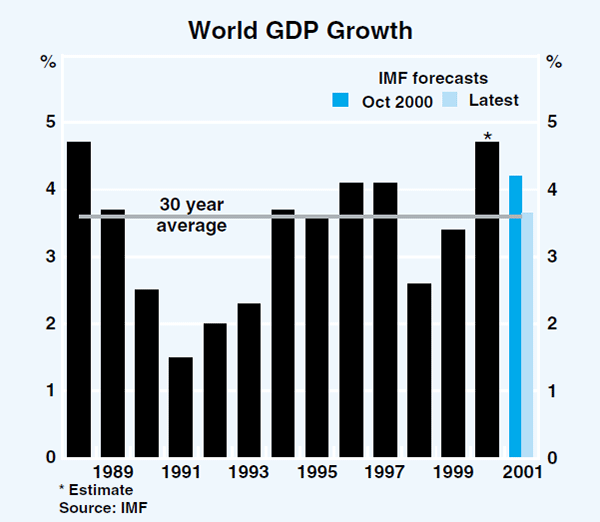
Although these forecasts still imply that global growth in 2001 will be quite good, at around the average level recorded over the past 30 years, downside risks to the outlook appear to predominate. Many commentators in the US, for example, are concerned that the slowdown could be sharper and more protracted than currently envisaged, and the continuing softening in equity markets reinforces this concern. Globally, there are concerns about the likely flow-on effects of the slowdown in US growth, through both real and financial channels.
Despite strong growth through 1999 and the first half of 2000, inflation remains low. During the last year, higher oil prices have increased headline consumer price inflation across many economies, but lower oil prices in recent months have started to unwind this effect. Core inflation rates have picked up a little from the rates recorded in 1999, but remain very low, and there is little evidence of any widespread second-round effects from the earlier increase in oil prices.
United States
The much anticipated slowing in the US economy commenced in the second half of 2000. The slowing appears to be sharper than was expected, with most private sector forecasters revising down their outlook for 2001 over the past three months. In response to the weaker outlook for activity, lower consumer and business confidence and tight conditions in some segments of the financial markets, the Federal Reserve Board lowered its target for the federal funds rate by a total of 1 percentage point to 5.5 per cent in January.
Indications of the slowdown, which saw growth in GDP slow to an annualised rate of less than 2 per cent, accumulated during the second half of last year (Graph 2). Initially these were concentrated in the housing sector, but over the last few months of the year, signs of significant slowing across the manufacturing and retail sectors became evident and employment growth weakened. Exports grew relatively strongly over the past year, despite the high level of the exchange rate, although they fell a little in the December quarter.
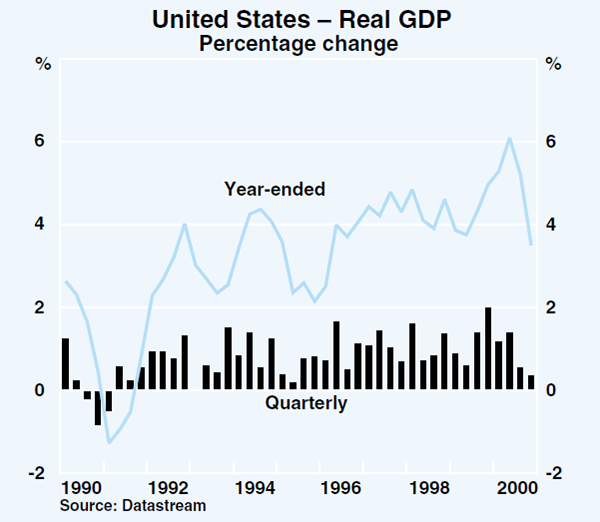
The decline in growth in the latter part of 2000 was, in part, driven by a reduction in the growth of consumer spending from the rapid pace that was recorded earlier in the year. Consumer spending increased at an annual rate of a little over 3½ per cent in the second half of 2000, following growth of around 5½ per cent over the previous year. Weaker employment growth, and the fall in household wealth, associated with declining share prices, may have contributed both to the softening in consumer spending and to the sharp deterioration in consumer sentiment that took place (Graph 3). The overall level of household wealth, however, remains high.
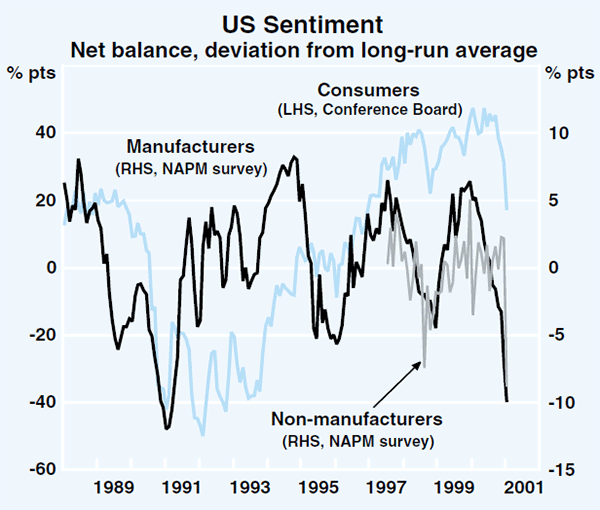
Business conditions also weakened during the last few months of 2000. In the manufacturing sector, there was a widespread fall in production across the traditional categories, particularly in motor vehicle production, and growth in information technology and communications (ITC)-related production eased a little. Total business investment fell in the December quarter, driven by a large fall in transport equipment, and a weakening in growth in ITC equipment spending. Non-residential construction spending, in contrast, remained relatively robust. The weakening in investment spending overall is not surprising, given the historically high rates of investment in recent years. Total business investment spending as a share of GDP remains around the peak level recorded in the early 1980s, and well above any level recorded since. The National Association of Purchasing Management survey implies a weak period for traditional manufacturers and non-manufacturing firms. The outlook for the ITC sector has also weakened in recent periods, although ITC equipment orders remain at high levels. Financial conditions facing businesses appear to have continued to tighten. According to the Federal Reserve Survey of senior loan officers, concerns about the credit quality of some borrowers have resulted in tighter credit conditions being imposed on bank loans. Spreads at the lower-quality end of the bond market have widened since mid 2000, although they have narrowed somewhat since early January.
Overall, the slowdown in activity in the latter part of 2000 translated into slower employment growth. In the four months to January employment growth averaged 100,000 per month – compared with the average of 150,000 per month that was recorded in the previous six months (adjusted for the impact of census workers). The unemployment rate edged up to 4.2 per cent in January.
After peaking in the middle of 2000, consumer price inflation declined modestly to 3.4 per cent over the year to December, primarily reflecting recent declines in oil prices after their earlier strong increases. Core measures of inflation remained at an annual rate of around 2½ per cent in the second half of 2000. The outlook for core prices continues to be subdued with growth in employment costs easing in the December quarter, slower activity likely to ease inflationary pressures in the non-traded sector and the current level of the exchange rate containing import prices.
Japan
The Japanese economy slowed during 2000, after having grown strongly at the beginning of the year (Graph 4). Revisions to the national accounts suggest that growth in the middle of 2000 was considerably lower than previously reported, with output declining in the September quarter, driven by a large fall in public investment. Slower export growth, combined with continued weakness in consumer spending, also contributed to the weaker outcome. Other indicators of activity also pointed to a moderation in growth during the second half of 2000. The Ministry of Economy, Trade and Industry's overall business activity index was broadly flat over the six months to November, after having increased by around 3 per cent over the previous year, and the Bank of Japan's Tankan survey implied that prospects for businesses deteriorated a little in the December quarter, although they remain well above their level of a year earlier.
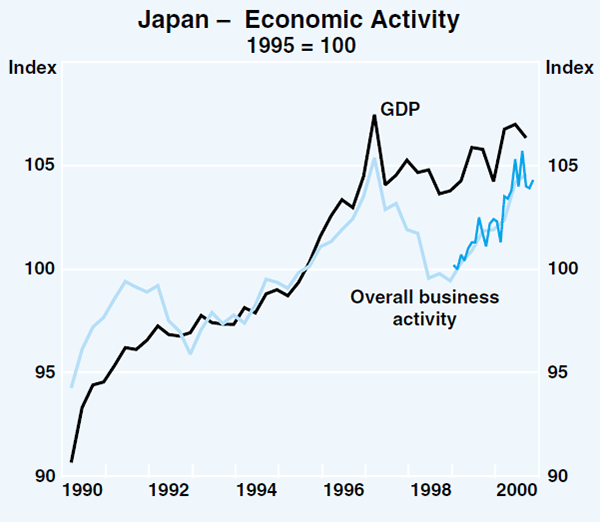
During the past couple of years, the main drivers of growth in Japan have been business investment spending and exports. The recovery in investment spending, evident since mid 1999, reflected an improvement in corporate profitability, particularly in the information technology sector, and was supported by external demand and concerted efforts towards consolidating operating costs at the firm level. The recovery in exports reflected strong demand in the rest of east Asia and the US. During the second half of 2000, however, external demand slowed and growth in machinery orders weakened, particularly for ITC equipment. The longer-term outlook for business investment thus appears to have deteriorated, although the lower level of the yen should provide some support to exporters in the period ahead.
The outlook for consumption remains uncertain. Little growth was recorded in consumer spending in the June and September quarters last year, following the large increase recorded in the March quarter, with weak growth in household incomes continuing to constrain consumer spending. Consumer sentiment, however, continued to improve through the second half of 2000, supported by growth of employment of nearly 1½ per cent over the period. Consumer sentiment is now a little above its long-run average level, and should provide support for consumer spending in the period ahead. Consumer prices have continued to fall on a year-ended basis, to be down by 0.2 per cent over the year to December.
Non-Japan Asia
The strong growth experienced in non-Japan Asia through the first half of 2000 continued into the second half of the year, with GDP expanding at an annualised rate of around 7 per cent in the September quarter (Graph 5).[1] Significant divergences in economic performance across the region have continued, however, with outcomes in Thailand, Indonesia and the Philippines remaining considerably weaker than the average. The strength in some of the economies in the region in 2000 surprised most commentators who had expected an easing in the rapid pace experienced since the recovery from crisis commenced. There are, however, signs that some slowing is beginning to occur, with external demand moderating and higher oil prices curtailing expenditure.
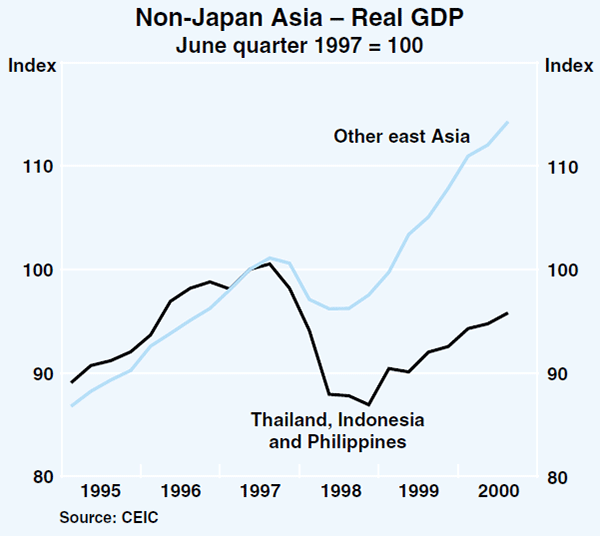
Exports continued to be one of the main contributors to growth during 2000, driven largely by the strength in world electronics demand, particularly in the US. The strength in electronics demand led, in turn, to a strong pick-up in investment spending on equipment, while construction investment remained weak. Consumer spending, in contrast, slowed during 2000 after having grown strongly over the past two years. This may reflect, in part, the fall in share markets across the region and related falls in consumer confidence, as well as the effect of higher oil prices.
More recently, there have been signs that industrial production and exports in the region are slowing, particularly in Korea and Taiwan (Graph 6). In Korea, industrial production in December was over 8 per cent below its peak in August and the value of exports was down 10 per cent in the December quarter. In Taiwan, industrial production has clearly weakened since the middle of 2000, to fall below its level of a year ago, and exports fell in the December quarter. Looking ahead, exports from the region as a whole could be adversely affected by any slowdown in US demand for ITC products.
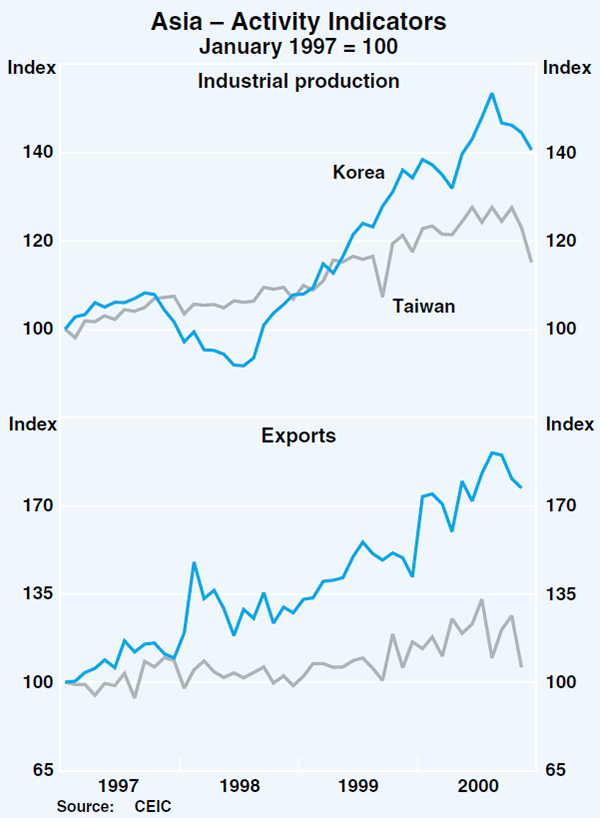
Inflation edged up in the region in the latter half of 2000, largely due to higher oil prices. However, inflation generally remains low, at rates around or below those prevailing prior to the 1997 crisis, in all of these countries except Indonesia.
New Zealand
The national accounts recorded a modest pick-up in GDP in New Zealand in the September quarter 2000, following the decline in the June quarter. Much of the slowing in June reflected weaker domestic demand, particularly housing and consumer spending. Business investment, in contrast, remained quite strong through the period. The external sector benefited from the competitive exchange rate and strong trading partner growth over much of 2000, with very strong growth in prices received by exporters and solid growth in export volumes in the first half of the year. Consumer prices rose sharply for the second consecutive quarter in December, taking headline inflation to 4 per cent, well above the RBNZ's 0–3 per cent target band. Much of the increase in the CPI in recent quarters, however, reflected the impact of higher oil prices and increased cigarette taxes. Excluding these factors, inflation is running at around 2.5 per cent.
Europe
The euro area expanded at a solid pace for the fifth consecutive quarter in September, albeit at a slower rate than was recorded earlier in 2000. Despite steady employment and wages growth, weak consumer spending was the main reason for the slowing. In part, this may have reflected the effect of higher petrol prices and interest charges on household cashflows. Business investment, in contrast, remained firm, underpinned by rising capacity utilisation as a result of the recent solid growth in industrial production and exports. While there are signs that growth in the euro area may have softened, the overall outlook remains favourable. Consumer sentiment continues to hold up at very high levels, and monetary conditions and the stance of fiscal policy are also supportive of continued steady growth. Business sentiment, however, has weakened since mid 2000, particularly in Germany.
Output in the UK increased by a modest 0.3 per cent in the December quarter, to be 2.4 per cent higher over the year. Indications are that the housing sector has softened and business conditions remain weak, as growth in industrial production and exports have been adversely affected by the strength of the exchange rate. Consumption growth has been robust, reflecting firm labour market outcomes, although there are signs that the labour market is softening, with employment flat in the September quarter and growth in job vacancies slowing in recent months.
International and Foreign Exchange Markets
Short-term interest rates
As evidence has emerged over the past couple of months that the US economy has slowed more quickly than previously expected, a marked change in market sentiment has taken place. Markets had been expecting that the monetary tightenings that began in most countries in 1999 had further to run, but they have now swung to expecting easings. As a result, short-term yields have fallen. This was most pronounced in the US, though was true in other major countries also. At the same time, the upward trend of the US dollar stalled, and bond yields also fell.
After raising the Fed funds target by 175 basis points, to 6.5 per cent, in the 12 months to May 2000, the Federal Reserve kept rates unchanged (but assessed that the risks were mainly toward heightened inflationary pressures) until the last meeting of the year on 19 December. At that meeting the Fed moved to a view that the risks were ‘weighted mainly toward conditions that may generate economic weakness in the foreseeable future’. Markets expected that this would mean that the Fed funds rate would be cut at the next Federal Open Markets Committee (FOMC) meeting at end January. Yields on 90-day securities moved down from 6.5 per cent in early December to 6.25 per cent by end December – i.e. 25 points below the then Fed funds target.
On 3 January, the Fed surprised markets by cutting the Fed funds target by 50 basis points to 6 per cent. This was the first inter-meeting move since October 1998, when the Fed eased following the financial market dislocation that followed the near collapse of a major hedge fund Long-Term Capital Management (LTCM). It was also the first 50 basis point cut since the early 1990s recession. At its 31 January meeting, the Fed cut policy rates by a further 50 basis points to 5.50 per cent, and continued to maintain its easing bias. In response to these developments, financial markets moved to price-in further easings, and 90-day yields fell to 5.25 per cent (Graph 7).
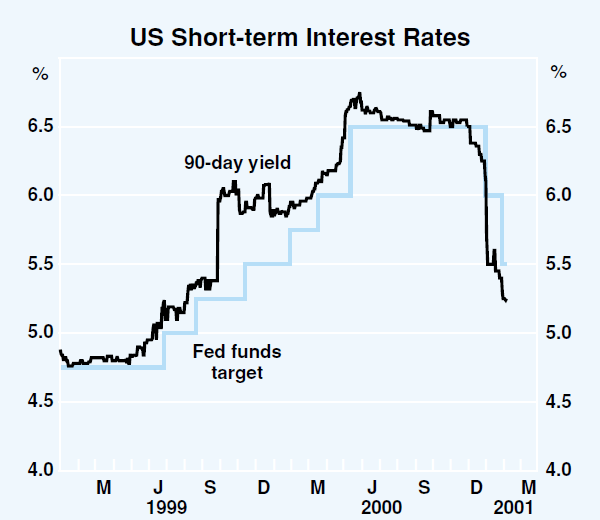
While the change in policy climate and sentiment has been most marked in the US, markets are assuming that the interest rate cycle has peaked in the other industrialised economies also. The Bank of Canada cut official interest rates by 25 basis points to 5.5 per cent on 23 January and the Reserve Bank cut rates in Australia by 50 basis points to 5.75 per cent on 7 February. Other industrial country central banks have kept official interest rates steady. The European Central Bank (ECB) last changed rates in October 2000, when it raised rates by 25 basis points to 4.75 per cent. This brought the total rise over the previous 12 months to 225 points. The Bank of England has held rates steady, at 6.00 per cent, since February 2000; and the Reserve Bank of New Zealand has left rates unchanged at 6.5 per cent since May 2000. Sweden was the last economy to increase official rates – by 25 basis points to 4 per cent in December. In Japan, overnight rates were raised in August 2000 thereby terminating the extraordinary ‘zero interest rate policy’ of the previous two years, but the Bank of Japan has left rates unchanged at 0.25 per cent since (Graph 8).
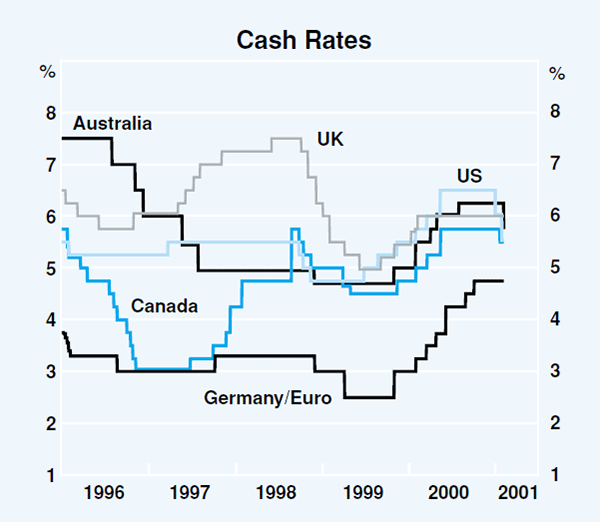
In all major countries apart from Japan, 90-day rates are currently below official rates, in marked contrast to the situation a few months ago (see Table 1).
| End Sep 2000 |
End Dec 2000 |
Current | |
|---|---|---|---|
| United States | 11 | −25 | −25 |
| Euro area | 49 | 7 | −6 |
| Japan | 7 | 15 | 8 |
| United Kingdom | 0 | −17 | −29 |
| Canada | 7 | −4 | −23 |
| Australia | 34 | −11 | −12 |
| New Zealand | 14 | 18 | −4 |
| Sweden | 20 | 0 | −2 |
The decision by the Fed to ease monetary policy enabled an immediate easing of monetary conditions in those emerging markets with exchange rates fixed to the US dollar – Argentina, Hong Kong and Malaysia. Signs of weaker growth in a number of other emerging markets, reflecting sluggish exports, have raised expectations of a more widespread easing in the monetary stance among these countries. The Philippines central bank has already lowered official interest rates in the past two months as political developments have allowed some unwinding of its aggressive tightening in October to underpin the peso at the time when political instability was rising.
Long-term interest rates
The changing economic climate has seen bond yields in the US fall sharply over recent months. Yields on US 10-year Treasury notes fell around 80 basis points between mid October and early January, reaching a low of 4.90 per cent before the first Fed easing. This fall was partly driven by the extreme instability in the US share market, which increased demand for more stable and secure investments such as government bonds. Since then, bond yields have increased modestly, to settle at around 5.20 per cent. The stabilisation of the US share market has contributed to this.
The US yield curve has been inverted for most of 2000, with the degree of inversion increasing to about 160 basis points in the days before the early January rate cut, a larger degree of inversion than that seen in the financial turmoil surrounding LTCM in 1998, and around the same as that seen in the lead-up to the early 1990s recession. While normally such a degree of inversion would be taken to indicate that markets are expecting a contraction in the economy, on this occasion several factors make it harder to interpret the implications of movements in yields. One of these is the continuing budget surpluses in the US and the resultant reduction in supply of bonds on issue, which may be dampening bond yields. This possible distortion is avoided by looking at yields on AAA-rated corporate bonds. The spread between these bonds and the cash rate also inverted in late December, though less markedly than that for Treasuries and also by less than in the lead-up to the early 1990s recession. This measure, however, is also affected by special factors at present – namely rising credit spreads on all private debt in the US. Nevertheless, it does suggest that markets do expect significant economic weakness ahead.
The spreads on corporate bonds in the US have increased significantly over recent months, suggesting an increase in concerns about credit quality in US markets. Spreads across the entire credit spectrum have risen, exceeding the highs seen in 1998 (Graph 9). Spreads on high quality AAA-rated paper relative to Treasury securities increased from around 80 basis points to 125 basis points over 2000. Spreads on the lower-quality bonds rose by more, with the ‘junk’ bond sector suffering the largest rise. Spreads on these latter securities moved to about 700 basis points over Treasury securities of comparable maturity, up over 300 basis points during the year. Since the Fed cut interest rates in early January, credit spreads have narrowed somewhat, suggesting that markets anticipate that the easing of monetary policy will contain the increase in corporate risk.
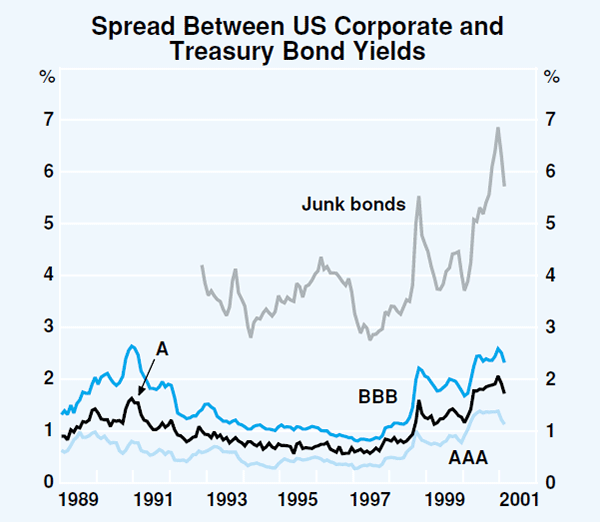
In European markets, yields on long-term government bonds have fallen in recent months, though less so than in the US. After trading in a relatively narrow range around 5.2 per cent for several months, the 10-year German yield moved down from mid November, falling by around 50 basis points by early January. Since then yields have risen by over 10 basis points to trade around 4.8 per cent. The spread between US and German 10-year government bonds narrowed by about 20 basis points, to around 40 basis points, over December and January. Japanese long bond yields increased modestly after the Bank of Japan ended the ‘zero interest rate policy’ in August 2000, reaching highs around 2.00 per cent, before falling back to their current level of about 1.50 per cent as weaker economic data accumulated in the latter part of the year (Graph 10).
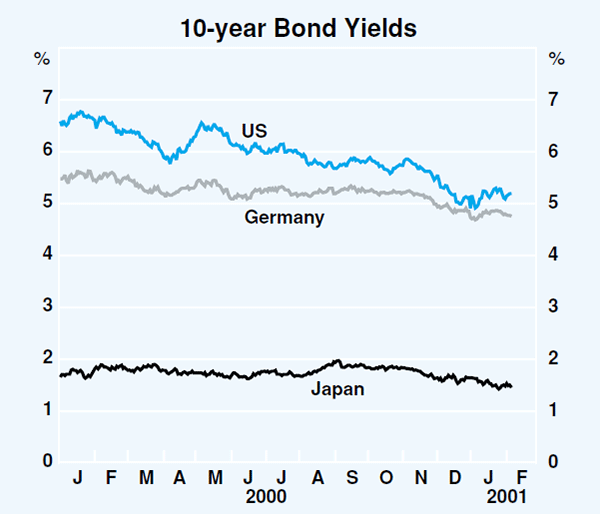
In emerging markets, bond yields rose through to December as markets became increasingly risk averse, both because of general concerns about the impact on emerging markets of the slowdown in the US and specific problems in several countries, particularly in Argentina and Turkey. The spread to US bond yields widened to almost 800 basis points, from a low of around 630 basis points earlier in the year. However, as with the US corporate market, the general risks surrounding emerging markets were seen to narrow somewhat as the Fed began to cut official interest rates in the US. This saw spreads fall back below 700 points by the end of January (Graph 11).
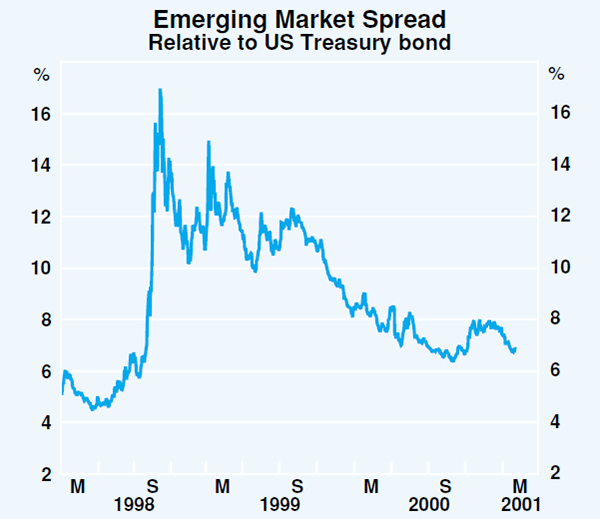
Equity markets
The prospect of significantly weaker economic growth and a string of disappointing earnings announcements, particularly by technology companies, have weighed on equity markets. US markets have led the fall over recent months. The Wilshire index, the broadest measure of US share prices (accounting for over 90 per cent of listed companies) fell by 14 per cent in the three months to early January. While the S&P 500 experienced similar falls, the Dow Jones index (which covers largely ‘blue chip’ stocks) was flat over this period as investors moved back toward lower risk investments. At the same time the technology rich NASDAQ fell around 35 per cent (Graph 12). All the major US stock indices saw large falls in 2000, the first year of negative returns for the broad-based indices since 1994. However, since the Fed began easing monetary policy, US equity markets have recovered modestly, with the Wilshire up 5 per cent, the Dow up 3 per cent and the NASDAQ up 14 per cent.
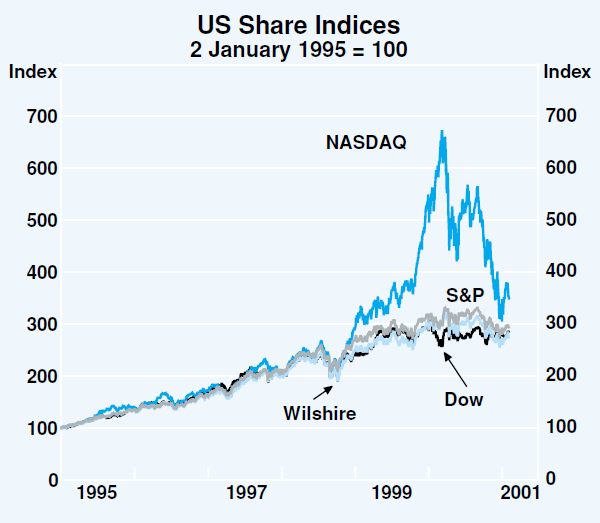
Share prices in most other countries have followed the US markets down over 2000. Depending on the composition of share price indices in the different countries, some peaked early in 2000, around the time of the peak in technology shares, while others experienced a later peak (Table 2). Broad–based indices in most countries were down by around 10 per cent over 2000. Only in two countries – Canada and Australia – did share prices show a net rise over the year.
| Change over 2000 |
Change since peak |
Change since 3 Jan 2001 |
|
|---|---|---|---|
| United States | |||
| – Wilshire | −12 | −16 | 5 |
| – Dow Jones | −6 | −7 | 3 |
| – S&P 500 | −10 | −12 | 5 |
| – NASDAQ | −39 | −48 | 14 |
| Germany | |||
| – DAX | −8 | −18 | 5 |
| United Kingdom | |||
| – FTSE | −10 | −10 | 3 |
| Japan | |||
| – Nikkei | −27 | −36 | −2 |
| Australia | |||
| – ASX200 | 3 | −2 | 3 |
| Canada | |||
| – TSE 300 | 6 | −20 | 6 |
Among the major countries, the biggest fall in share prices in 2000 was in Japan. Share prices in that country fell sharply in the first half of 2000 as the Japanese index was heavily affected by the collapse of technology stocks. More recently, pessimism regarding the outlook for the Japanese economy led to a further substantial slide in share prices, with the Nikkei falling to levels not seen since the Asian crisis.
As Japanese equity prices fell, the market began to focus on the potential impact on the solvency of the Japanese banking sector and, given the banks' role in funding the corporate sector, on the economy more generally. However, despite continuing problems with the banks' balance sheets, price-based market assessments of the banking industry do not appear to have deteriorated significantly over the past year. The market value of bank shares has not under-performed the market average, as was the case in the lead-up to the banking problems of 1998 (Graph 13). In addition, the ‘Japan premium’ (the additional margin which Japanese banks must pay to borrow short-term funds on world markets) remains negligible, compared with a peak of around 80 basis points at the time of the banking crisis in 1998. The recapitalisation package announced in October 1998 helped reduce this premium.
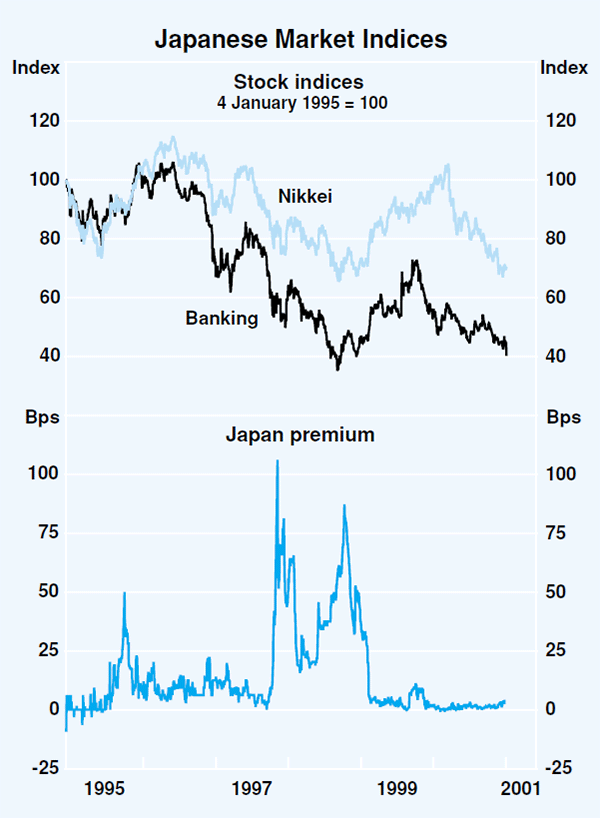
Equity prices in the Asian-crisis economies – Indonesia, Korea, Malaysia, Philippines and Thailand – experienced average falls in the order of 40 per cent in 2000, to levels only marginally above those reached during the 1997–98 financial crisis (Graph 14). The slump was largely due to an assessment by markets that these economies were vulnerable to slowing world growth, and in particular to a downturn in the global electronics cycle. However, since the first easing by the US Fed, share prices in the region have recovered modestly, rising by 10 per cent in the year to date. Latin American share prices also registered a recent upturn, following weakness in 2000.
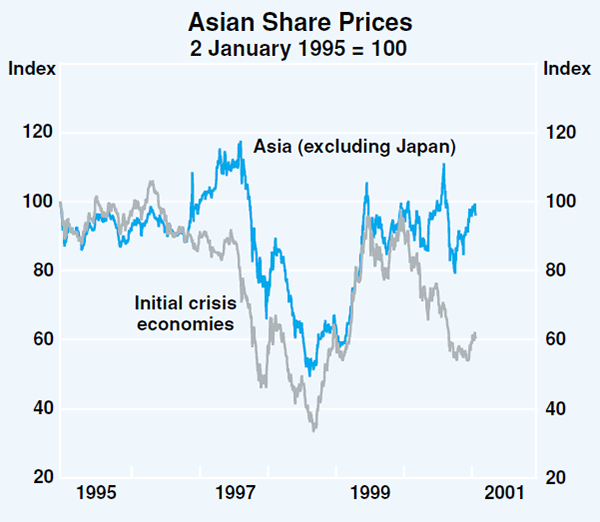
Exchange rates
The past few months have seen a fundamental change in the momentum underpinning movements in the three major global currencies. After strengthening significantly on a trade-weighted basis over recent years, the US dollar peaked in mid November as evidence emerged that the US economy was slowing significantly. Between mid November and the start of January, the trade-weighted US dollar fell by 5 per cent, after increasing 13 per cent up until that point in 2000 (Graph 15). The Fed's surprise easing in early January prompted a further move downward in the dollar. However, as markets have come to see this as an indicator of the Fed's determination to prevent a prolonged slowdown in the US economy and some of the gloom surrounding the economic outlook dissipated, the US dollar stabilised and has since moved modestly higher against the major currencies (other than the yen).
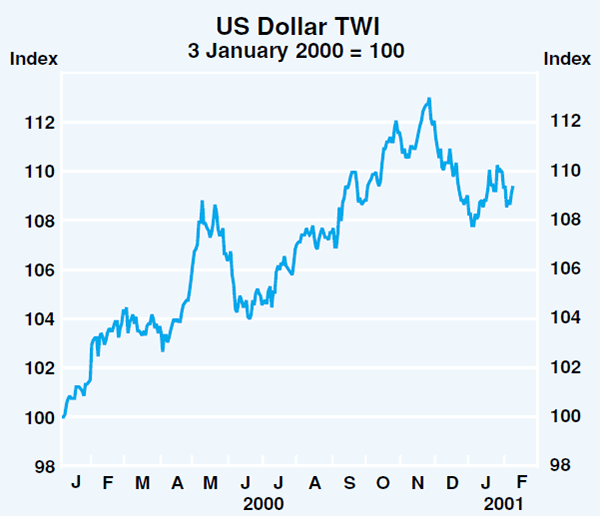
The peak of the US trade-weighted index broadly coincided with the trough in the Euro/US dollar bilateral exchange rate. From its introduction at the beginning of 1999, the euro fell by close to 30 per cent to an historic low of US82.3 cents in October 2000. Concerted intervention by the G7 central banks in September, and subsequent bilateral intervention by the European Central Bank, helped to stabilise the euro, which then strengthened by over 15 per cent to reach a peak of US95.8 cents in early January, immediately after the US Fed's surprise easing. More recently the Euro has fallen again against the US dollar as the bearishness regarding the US dollar has eased (Graph 16).

Despite the slowdown in the US economy, the yen has weakened against the US dollar in recent months. After trading in a 105 to 110 range between January and November 2000, the yen fell to almost 120 against the US dollar by mid January. It has since generally remained in a range of 115 to 120.
Elsewhere in Asia, the currencies of countries with floating exchange rates appear to have stabilised against the US dollar after falling through most of 2000 (Graph 17). This has gone hand-in-hand with a modest recovery in domestic share markets in the region. Most floating Latin American currencies also depreciated against the US dollar over the course of 2000, but there too the trend may have been arrested recently. The Brazilian real has been stable in recent months, and the Mexican and Chilean pesos have appreciated marginally against the US dollar.
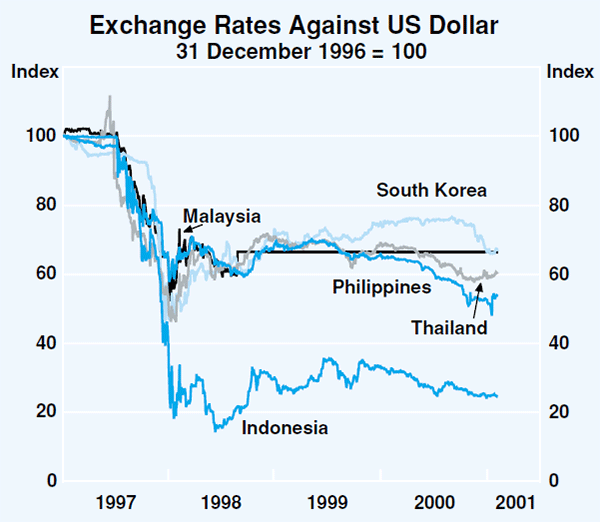
Australian dollar
Movements in the Australian dollar have to a large degree continued to reflect fluctuations in investor sentiment towards the US dollar. The strong demand for US dollars that characterised most of 2000 eventually moderated late in the year with the run of weak economic data in the US and, shortly after, the surprise monetary policy announcement. The resulting fall in the US dollar on world markets saw the Australian dollar rise quite sharply against it between late November and early January, as did all other major currencies apart from the yen.
The winding-back of expectations of the growth of US economic activity was evident throughout the December quarter but particularly late in the quarter. The US dollar stopped rising in trade-weighted terms in November and the Australian dollar stabilised at around US52 cents. This emerging tendency towards stability was assisted by several rounds of quite sizeable intervention by the Reserve Bank to support the exchange rate. Though the Australian dollar briefly fell to a low of US50.7 cents in late November, it recovered sharply to above US55 cents in December as growth estimates for the US continued to be wound back much more quickly than those for Australia (Graph 18).
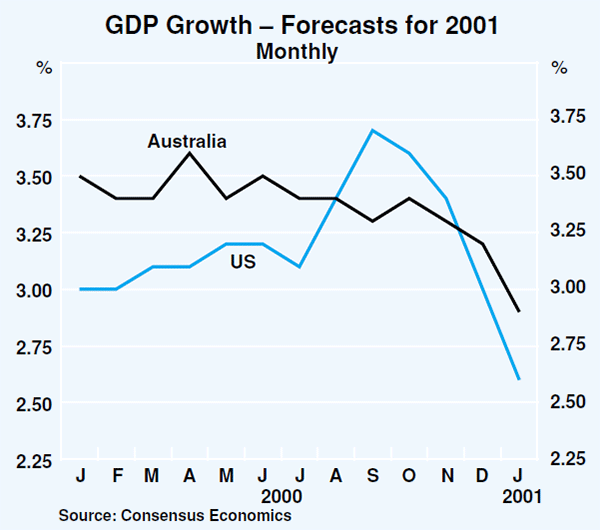
The announcement of a 50 basis point cut by the Fed in early January surprised most observers, and tended to weaken the US dollar immediately after the announcement. At that time, the Australian dollar climbed briefly above US57 cents, more than 10 per cent above its November low. Thereafter, as US asset markets settled, sentiment about the US dollar improved. At the same time, the consensus growth outlook for Australia was also reduced more sharply. The Australian dollar declined to around US54–55 cents (Graph 19). Markets had already fully priced-in the 50 basis point easing in Australia in early February and its announcement had little impact on the exchange rate.
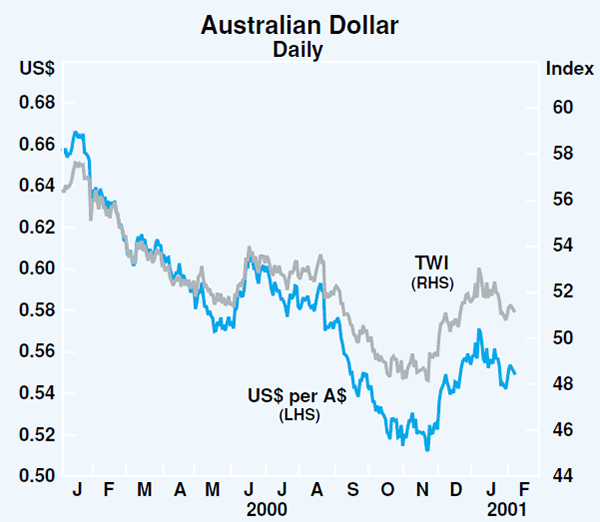
With the US dollar remaining the major focus of markets in recent months, most other major currencies (except the yen) have shown similar movements against it (Graph 20). This has meant that correlations between the Australian dollar and these other currencies, particularly the euro, have been much higher than usual. Correlations of daily movements between the euro and the Australian dollar have increased to around 0.75 from 0.25 early last year and an average of close to zero during the 1990s (Graph 21). The most recent observations are comparable with the correlation between the Australian dollar and the US dollar when the local currency was regarded as being one of the ‘US dollar bloc’ currencies. That strong relationship, which had been prevalent throughout most of the floating period, broke down around 1997 when markets brought about a significant depreciation of the local currency in reaction to the onset of the Asian crisis.
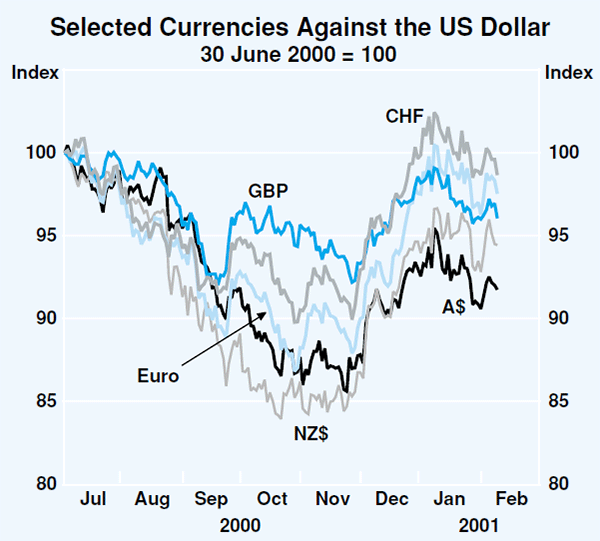

Even though the Australian dollar has been quite steady against many other currencies, the trade-weighted index rose noticeably in the closing weeks of last year and early this year. This reflected in part the importance of the US dollar in the TWI, but also the fact that the yen weakened at the same time; together, these two currencies (and currencies tied or managed to the US dollar) make up about half the trade weights.
With the recovery of the Australian dollar from its lows in November, the Bank has remained out of the market, except for a few occasions in December and January when market liquidity was seasonally low and the Bank intervened on a small scale to ensure that the exchange rate did not behave erratically in the thin conditions.
Domestic Economic Activity
Growth in the Australian economy slowed in the second half of the year, after a very strong first half. The extent of the slowdown is difficult to gauge as most indicators of the pace of activity have been influenced by the introduction of the new tax system and, to a lesser extent, by the staging of the Olympic Games. At the same time, the composition of growth has continued to shift, with stronger growth in exports providing some offset to the weaker growth in domestic demand (Graph 22, Table 3).
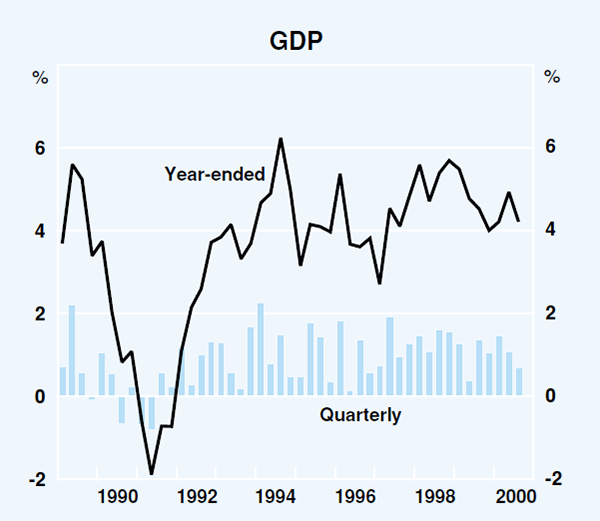
| Six months to: (annualised rate) |
September quarter 2000 |
||
|---|---|---|---|
| March quarter 2000 |
September quarter 2000 |
||
| Private Final Demand(a) | 5.1 | −0.9 | −1.5 |
| Consumption | 4.6 | 3.2 | 0.7 |
| Dwelling Investment | 21.6 | −29.2 | −21.5 |
| Business Investment(a) | −0.9 | −2.0 | −0.2 |
| Public Final Demand(a) | 10.5 | 0.8 | 2.2 |
| Change in Inventories(b) | −1.7 | 1.3 | 0.6 |
| Exports | 11.7 | 13.2 | 3.8 |
| Imports | 10.6 | 0.6 | 0.4 |
| Net Exports(b) | −0.2 | 2.4 | 0.7 |
| Gross Domestic Product | 5.0 | 3.4 | 0.6 |
| (a) Excluding transfers between the public and private sectors (b) Contribution to GDP growth |
|||
The increase in real GDP of 0.6 per cent in the September quarter recorded in the national accounts was less than that in recent quarters, but was particularly affected by the changes to the tax system and the Olympic Games. The net effect of the GST was to transfer activity from the second half of the year into the first half. This was most prevalent in the housing sector where the fall in dwelling investment in the September quarter subtracted around 1¼ percentage points from growth. The new tax arrangements also affected the timing of some consumption spending, most notably motor vehicle purchases, and business investment spending.
In contrast to the effects of the tax system, the Olympics provided a net boost to GDP in the September quarter. The direct effect in the form of higher exports (broadcast rights and ticket sales to non-residents) and consumption (ticket sales to residents) is estimated to have been just under ¾ of a per cent of GDP, but this will have been offset to some extent by the diversion of spending from other forms of consumption and the disruption to business activity during the staging of the Games. The most recent indicators suggest that the slower overall pace of growth continued in the last few months of the year.
Household consumption
Consumer spending grew at a more moderate pace over the past year. Household consumption increased at an annualised rate of 2 ¾ per cent in the September quarter, compared with growth of around 5 per cent per annum in recent years. While retail trade increased strongly in the December quarter, there is no doubt that the strong consumption growth of recent years has slowed.
A number of factors have contributed to reduce the growth of consumption, including the rise in the interest burden of households due to increases in household debt and the tightening of monetary policy since November 1999, and a slowdown in the accumulation of household wealth. Higher petrol prices are also likely to have led households to reduce spending on other goods and services, along with the requirement for some households to pay the second instalment on their purchases of shares in the Telstra 2 float by early November. These contractionary influences have been partly offset by continued strong growth in household borrowing and the boost to household income from the tax cuts and benefit increases associated with the new tax system.
Consumption growth as recorded in the September quarter was boosted by domestic sales of Olympic tickets and domestic tourism expenditures as residents of other states travelled to watch the Games. However, the tendency for households to spend more time at home or involved in Olympics-related activities is likely to have reduced expenditure in other areas over this period.
There was also a marked shift in consumption patterns between the June and September quarters as a result of the relative price changes associated with the introduction of the new tax system. The largest shift in expenditure was on motor vehicles, which was around 40 per cent higher in the September quarter than in the June quarter, reflecting the lower taxes and hence prices after 1 July. Motor vehicle sales have remained at a high level in recent months, though somewhat below the initial spike when the tax changes were introduced (Graph 23). These price effects were amplified by manufacturers' decisions to delay the launch of a number of new models onto the Australian market until after 1 July. Other areas of expenditure such as clothing and footwear and household furnishings declined following the tax changes as consumers had brought forward their expenditure to earlier quarters in anticipation of higher prices after 1 July.
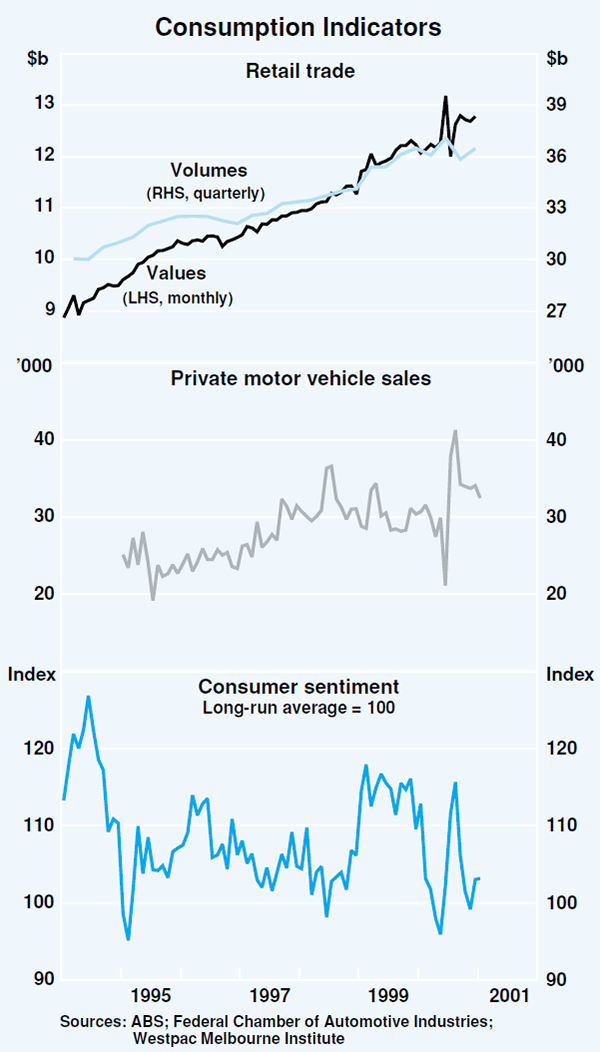
The pace of retail spending, which accounts for around one-third of total consumer spending, also slowed in 2000. Retail spending has been particularly volatile over the course of the year because of the changes in the tax system. It fell by 3.3 per cent in real terms in the September quarter, but rose by 1.8 per cent in the December quarter so that its level in the second half of 2000 was lower than in the first half. The slowdown has been most noticeable in spending on clothing, recreational goods and hospitality and services.
In line with the slowdown in consumption growth, consumer sentiment has fallen from the high levels of 1999. It has varied considerably over the past year, reflecting uncertainty about the impact of the tax changes, financial market volatility and higher interest rates and petrol prices. Nevertheless, in recent months consumer sentiment appears to have stabilised at a level slightly above its long-run average, which would be consistent with continued moderate growth in consumption.
Household disposable income grew by around 4 per cent in the September quarter, boosted by the increase in social assistance benefits and decrease in income taxes associated with the changes to the tax system. The sharp increase in disposable income combined with the slowdown in growth in consumption expenditure resulted in an increase in the household saving ratio to 4 per cent of disposable income in the quarter, up from 2.7 per cent a year ago.
Growth in household borrowing has moderated from the very fast pace of the first half of last year, mainly reflecting a deceleration in lending for housing, and particularly lending for investment property. Personal credit growth has also eased a little in recent months though it remains strong, especially in the form of credit card and overdraft lending. Total credit to the household sector increased at an annual rate of around 11½ per cent over the six months to December, down from a rate of nearly 18 per cent in June, a figure which had been boosted by the pre-GST surge in housing activity.
While the overall rate of growth of household borrowing has declined in recent months, it continues to exceed the growth of incomes, and hence the ratio of household debt to disposable income has increased further. This continues a trend that has been evident in Australia for more than a decade. In large part, the trend increase in the debt-to-income ratio represents a long-term structural change – households have been adjusting to a deregulated financial system in which credit has become more freely available and, with lower interest rates, is more affordable. In the course of this process, the Australian household sector has moved from having a relatively low level of debt by international standards to a position where the debt ratio is comparable to that in other countries (Graph 24). (If unincorporated enterprises were included, the debt ratio in Australia at present would be around 10 percentage points higher than is shown in the graph.)
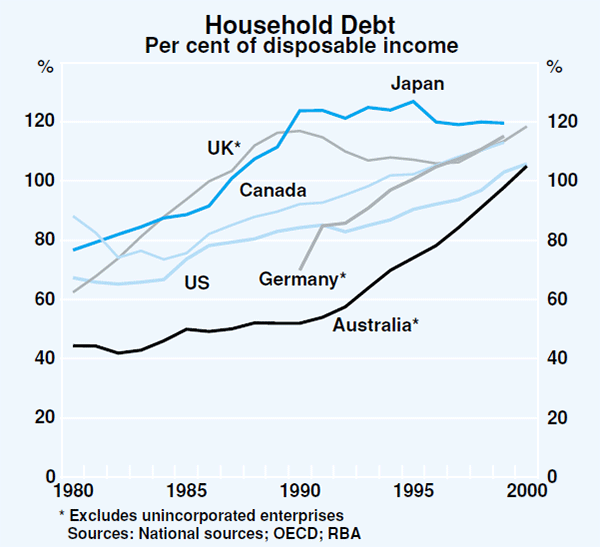
While it is difficult to establish what would be a sustainable debt ratio for the household sector in the longer term, the rapid increase does pose the risk of some households becoming overstretched, particularly if the level of borrowing were to continue growing at the rates seen in the past couple of years. One measure of the capacity of households to service their debt is the ratio of interest payments to disposable income. The combination of increased household indebtedness and higher interest rates in the past year has seen this ratio continue to increase, to a level higher than the most recent peak reached in the mid 1990s, but still well below the late 1980s peak (Graph 25).
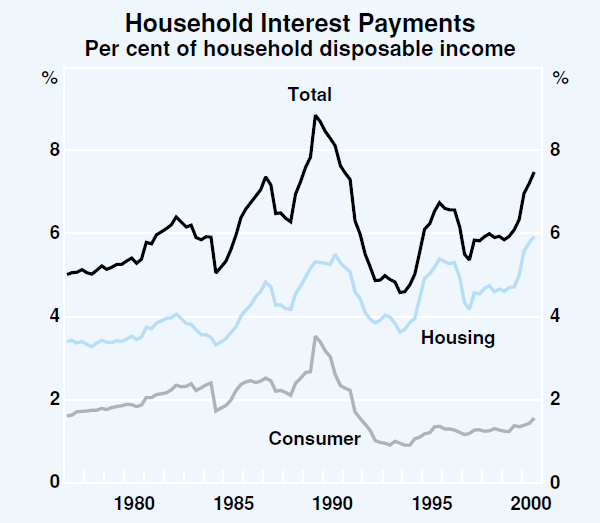
After increasing at a relatively rapid pace for much of the past four years, growth in the value of household assets has slowed considerably in recent quarters. The pattern is difficult to gauge because measures of the value of houses, which account for the bulk of household assets, have been distorted by compositional changes in the mix of house buyers related to the introduction of the new tax system. The availability of the Federal Government's First Home Owner Grant after 1 July (and a concession on stamp duty in NSW) encouraged first-home buyers to delay their house purchases until the September quarter. As first-home buyers are likely to buy cheaper dwellings on average, this boosted the average purchase price in the June quarter and depressed it in the September quarter. The CBA/HIA measure of established house prices, which is likely to be most affected by this change, fell by 10.5 per cent in the September quarter, after rising by 5.2 per cent in the June quarter (Graph 26). The REIA and ABS measures of house prices, which are less affected, fell by 3.8 per cent and 0.1 per cent, respectively, in the September quarter.
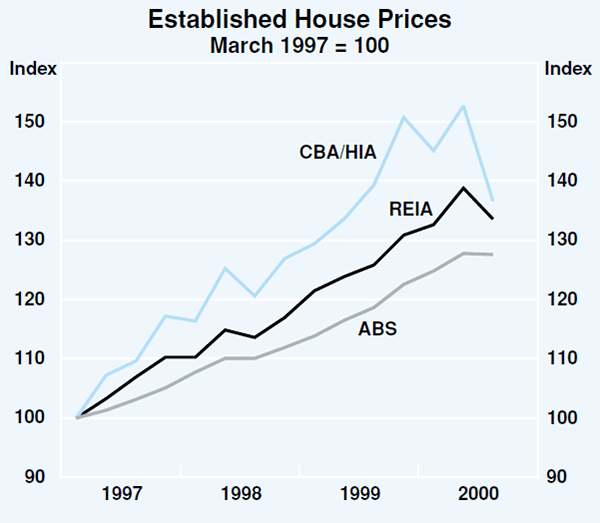
Growth in household financial assets has also slowed in recent quarters (Table 4), primarily reflecting slower growth in the value of both direct and indirect equity holdings. Nevertheless, the value of household direct equity holdings has continued to rise, in contrast to the US where the value of household direct equity holdings fell by around 13 per cent in the six months to the September quarter.
| Level $b | Share of financial assets (per cent) |
Annualised growth (per cent) Six months to: |
||
|---|---|---|---|---|
| Mar quarter 2000 |
Sep quarter 2000 |
|||
| Currency and deposits | 257 | 21.8 | 3.4 | 8.8 |
| Direct equity holdings | 240 | 20.3 | 33.3 | 7.6 |
| Superannuation and life offices | 618 | 52.4 | 19.2 | 6.7 |
| – Equities | 307 | 26.1 | 41.0 | 15.8 |
| Other | 64 | 5.5 | 0.5 | −11.1 |
| Total financial assets | 1,179 | 100.0 | 16.8 | 6.2 |
Dwelling investment
Following record growth over the year to June 2000, residential construction activity declined sharply in the second half of the year. According to the national accounts, private dwelling investment fell by more than 20 per cent in the September quarter, to be around 7 per cent lower than a year earlier, with sharp falls in both the construction of new dwellings and alterations and additions. As a share of GDP, dwelling investment fell from around 6½ per cent to 5½ per cent – although this returned it only to the same level as at the two previous cyclical peaks (Graph 27). Forward indicators point to a further, though much smaller, decline in activity in the December quarter.
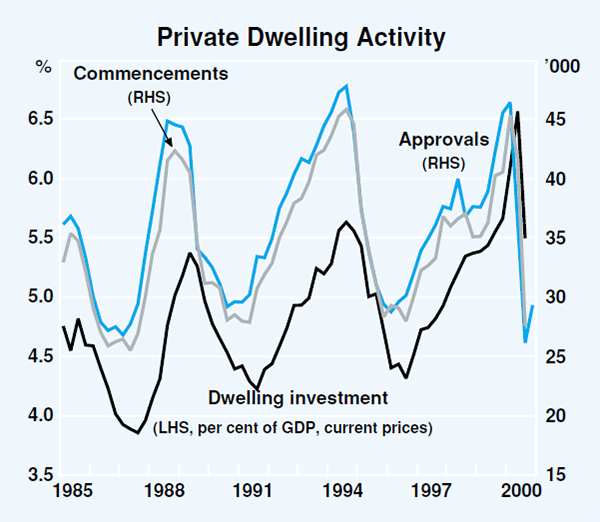
The shape of this housing cycle has been significantly affected by the introduction of the GST, which created the incentive for dwelling construction to be undertaken before 1 July. Combined with the effects of the rise in interest rates, this led to the very sharp decline in activity in the housing sector in the second half of 2000. In contrast to previous dwelling cycles, at this stage there is little evidence of a large oversupply of dwellings, which suggests that the downturn may not be as protracted as in the past. In addition, the prospects for a recovery in the dwelling sector have been bolstered by an increase in affordability in recent months as growth in house prices appears to have eased and as fixed home loan rates have declined.
Dwelling activity is likely to fall further in the December quarter and leading indicators suggest that the lower level of activity is likely to persist into the first part of 2001. However, a number of forward indicators appear to have reached bottom and suggest some pick-up in activity is in prospect later in 2001. The number of private new dwellings approved has increased in the last quarter of 2000, to be 12 per cent above the trough reached in September, although they remain 36 per cent lower than a year earlier (Graph 28). The increase in approvals has been evenly spread across houses and medium-density units. The number and value of loan approvals rose strongly in November, recovering from the low levels recorded in September and October. Much of the strength was in lending to investors although loans to owner-occupiers also picked up. The downturn in the housing sector has been broadly similar in magnitude across the states, and most states have shown signs of a recovery in recent months.
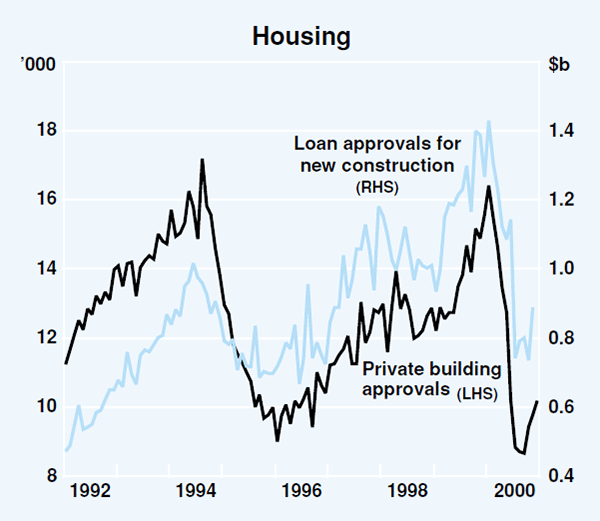
The business sector
Reflecting the varying economic conditions, business surveys have reported marked differences in business sentiment across industries. The ACCI-Westpac survey of manufacturing firms reported a decline in expected business conditions over the next six months. The Dun and Bradstreet survey, which focuses on the manufacturing, wholesale and retail trade sectors, also reported a decline in the period ahead. In contrast, the more broadly based ABS Survey of Business Expectations and NAB quarterly survey reported an expectation of a significant improvement in business conditions over the coming year in the mining sector, and a continuation of buoyant conditions in the property and business services sector, but a worsening in conditions in most other sectors. The NAB survey also indicated that exporters were enjoying good conditions.
In addition to the variation across industries, there have also been major differences in sentiment between smaller and larger businesses. According to the ABS Survey of Business Expectations, large firms have a positive outlook for sales and profit growth over the coming year whereas small firms are reporting a sharp deterioration in sales and profit growth.
Notwithstanding this variation across sectors, the business surveys consistently suggest a deterioration in business sentiment for the economy as a whole in the second half of 2000. The survey responses are, however, less definitive on the exact causes of this change. In general, businesses report, as they almost always do, that the factor most constraining production or profitability is demand or orders, with an array of other factors playing a minor role (Table 5). There have been only minor changes to this pattern of late, and hence it is necessary to look beyond the survey responses in forming an assessment of the reasons behind the decline in confidence.
| NAB Survey(a) | ACCI-Westpac Survey(b) | ||
|---|---|---|---|
| Demand | 47 | Orders | 71 |
| Wage costs | 9 | Capacity | 5 |
| Exchange rate too low | 9 | Labour | 3 |
| Recent tax changes | 7 | Finance | 1 |
| Interest rates | 5 | Material | 0 |
| Exchange rate too high | 5 | ||
| Availability of suitable labour | 5 | ||
| Inadequate capital capacity | 4 | ||
| Other | 8 | ||
| (a) Respondents were asked in December 2000 to nominate the factor most
constraining profitability over the next 12 months. (b) Respondents were asked in November 2000 to nominate the major factor limiting production. |
|||
On this occasion, the extremely sharp downturn in housing activity in the second half of 2000 has reduced demand and employment, not only in the housing industry itself but in those parts of manufacturing that supply the housing sector. Also, higher petrol prices have reduced the amount of income that consumers have available to purchase other goods and services. Similarly, higher import prices have contributed to a squeeze on margins in some parts of manufacturing, wholesaling and retailing, although in other parts of the economy such as those that export or compete against imports, profit opportunities have expanded. According to the Yellow Pages survey, small businesses also had some difficulty in changing accounting and record-keeping systems to comply with the new tax system. The rise in interest rates earlier in the year would also have contributed to some reduction in business confidence, particularly during the period when further increases were expected. Finally, over the most recent few months, the gloomier news from the United States, particularly concerning its share markets, would have influenced business confidence in Australia.
The transition to the new tax system has meant that companies will be paying tax on income earned in the current year at the same time that they are paying tax on income earned in 1999/00. Transitional arrangements have been implemented to alleviate this problem by allowing some payments to be deferred (see Box A), and hence this should not have a major effect on business cash flow provided businesses take full advantage of the deferral arrangements. In its Mid-Year Economic and Fiscal Outlook (MYEFO), the Government reported that there appeared to be a short lag between when businesses report GST receipts on sales and when they claim input tax credits relating to those sales, and also that there was a lag in the processing of net refunds by the Australian Tax Office.
Aggregate measures suggest that, on average, the financial position of the corporate sector has remained strong. Corporate GOS rose by over 17 per cent over the year to September and was at an historical high as a share of GDP (Graph 29). Profit growth in the mining sector has been particularly strong over the past year, whereas profit levels in the retail and wholesale sectors appear to have fallen. There is some evidence that conditions for small business are less favourable, with profits of unincorporated enterprises falling by 1.2 per cent in the September quarter, although they are nearly 6½ per cent higher over the year.
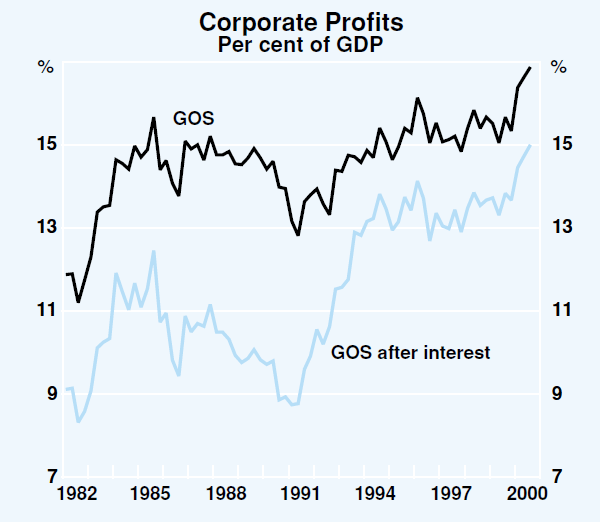
The business surveys reported lower profitability in the December quarter, although again there was variation across sectors and between small and large businesses (Graph 30). The broadest measure shown by the NAB survey indicated that profitability had fallen to about the same level as in 1996. The Dun and Bradstreet survey and the ACCI survey of manufacturing showed a similar result. On the other hand, the survey of manufacturing carried out by the Australian Industry Group and the Yellow Pages survey of small business, showed profitability at a lower level than in the mid 1990s.
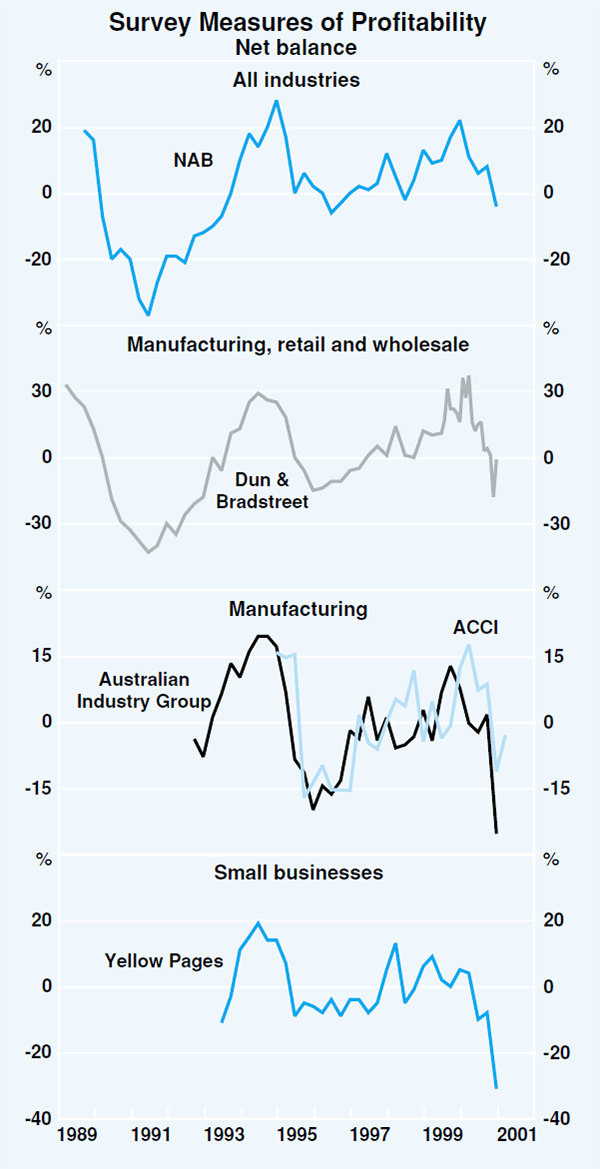
Aggregate business investment has been flat for a number of quarters, although this masks contrasting developments in the components of investment. Investment in new machinery and equipment increased by nearly 5 per cent in the September quarter (Graph 31) and by 8 per cent over the past year. Some part of the increase in the September quarter may have reflected the deferral of purchases to take advantage of the fall in the price of some investment goods with the abolition of wholesale sales tax. The outlook for investment in machinery and equipment for 2000/01, as measured in the latest ABS Capital Expenditure Survey appears quite positive. Firms upgraded their machinery and equipment investment plans significantly, implying around 6 per cent growth in nominal terms over 2000/01. Much of the expected growth is in the communications, property and business services and mining sectors, where recently business sentiment has been more buoyant.
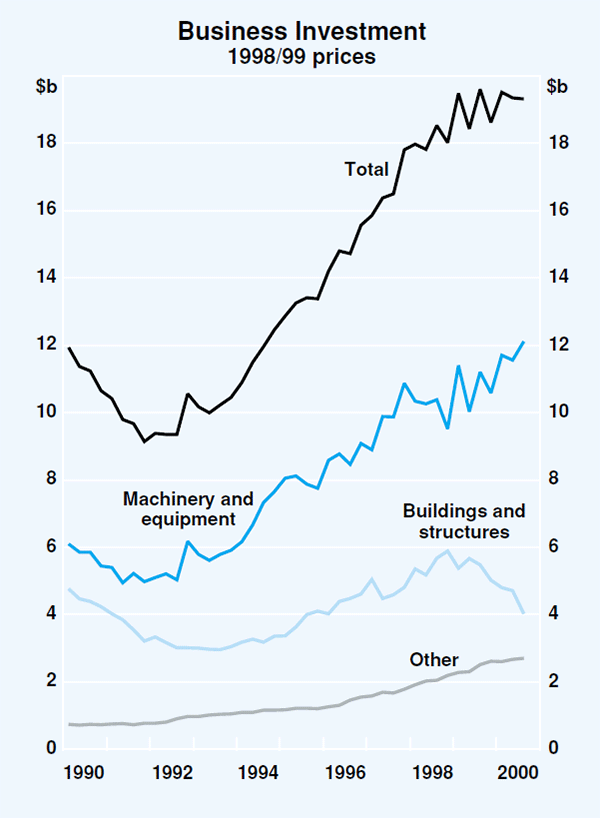
New investment in buildings and structures continued to decline from the peak reached almost two years ago, falling by a further 15 per cent in the September quarter. Expenditure on engineering construction has been particularly weak and is around one-third lower than a year earlier. Much of this decline has been due to weakness in resource-related projects, although in the September quarter, work done on infrastructure projects also declined. While committed projects in the quarter, as reported in the Access Investment Monitor, rose to their highest level since the early 1990s, many of the major projects are still in the planning stage and are likely to have little impact on work done until well into 2001/02. However, non-residential building approvals point to an increase in office construction, underpinned by the gradual tightening in CBD office space availability and the consequent strong growth in office rents.
The other major component of business investment, expenditure on intangible fixed assets, rose moderately in the September quarter to be nearly 8 per cent higher than a year ago. Increases in expenditure on computer software (around 80 per cent of the total) and minerals and petroleum exploration contributed to the growth in the quarter. The increase in exploration expenditure, together with strong profitability, points to the possibility of a rebound in capital expenditure in the mining sector, which has been subdued for a number of quarters.
The availability of funds is not likely to be a constraint on business investment. As discussed above, profit levels are high, even if down a little from their September quarter peak. Net equity raisings have also been high with gross raisings remaining buoyant and buy-back activity easing. At the same time, businesses have not been using debt financing as much recently, possibly reflecting higher interest rates charged by intermediaries and the slowdown in economic activity. Business credit growth has slowed to an annualised rate of around 5 per cent over the six months to December from 13 per cent over the six months to June. In the December quarter, the slowing in intermediated business borrowing was offset to a small degree by increased debt raising through capital markets (see the chapter on ‘Domestic Financial Markets’).
Measures of the corporate interest burden remain low by historical standards, reflecting a combination of high profitability and relatively low levels of interest rates and corporate indebtedness (Graph 32). Debt-to-equity ratios have been broadly flat over the past few years, and remain well below levels of a decade ago.
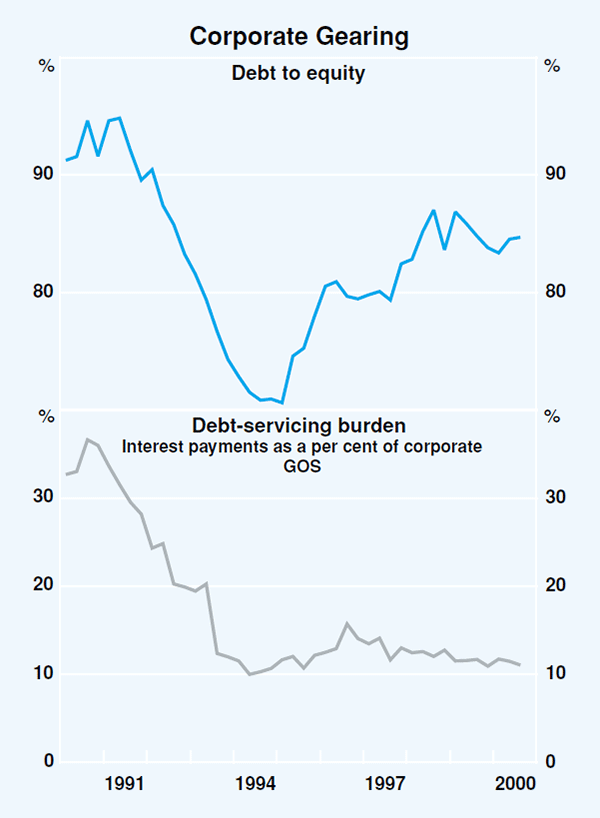
Commonwealth Budget
In November the Commonwealth Government reassessed its budget forecasts in its Mid-Year Economic and Fiscal Outlook (MYEFO). The expected underlying cash surpluses for 2000/01 and for 2001/02 were both revised up by about $1½ billion, while the estimate of the actual surplus in the previous year was revised upwards by a larger amount. The revision to the estimate for the current year in part reflected upward revisions to forecasts of GDP and employment growth, and ongoing base effects of stronger-than-expected tax receipts in 1999/2000. Higher Pay-As-You-Go withholding tax receipts, company tax receipts and the petroleum resource rent tax contributed the most to the upward revision to revenue in 2000/01. The upward revision to expected revenue was partially offset by higher expenditures.
While the estimated level of the surplus for both the current and the previous year has been revised upwards, the revised estimates suggest that the Commonwealth Budget position remains expansionary in its impact on growth in the economy in the current fiscal year. Using the change in the surplus between years as a rough indicator of the impact on growth, the revised estimates indicate that the surplus in 2000/01 will be 1.4 per cent of GDP lower than in the previous year. This compares with an estimated reduction of 0.8 per cent of GDP at budget time (Table 6). Subsequent to the latest estimates, the Government has announced spending packages on roads and innovation worth $1.6 billion and nearly $3 billion respectively over the next five years, with most of the impact occurring in the later years of that period.
| 1998/99 | 1999/00 | 2000/01 | 2001/02 | |
|---|---|---|---|---|
| Budget | 41,90 | 7,795 | 2,844 | 3,211 |
| (0.7) | (1.2) | (0.4) | (0.5) | |
| MYEFO | 4,190 | 12,671 | 4,329 | 4,738 |
| (0.7) | (2.0) | (0.6) | (0.7) |
The labour market
Conditions in the labour market have softened in recent months, with employment growth slowing from the rapid pace experienced around the middle of the year and the unemployment rate edging up after having fallen to its lowest level in a decade in the September quarter (Graph 33). After rising by 3.5 per cent over the year to the September quarter 2000, employment fell by 0.5 per cent in the December quarter, but remained 2.2 per cent higher than a year earlier. The unemployment rate rose slightly in the December quarter to 6½ per cent, around ½ of a percentage point lower than in the December quarter 1999. Employment fell slightly in January, and the unemployment rate increased to 6.7 per cent. The participation rate has declined from its recent peak but remains a little higher than a year earlier.
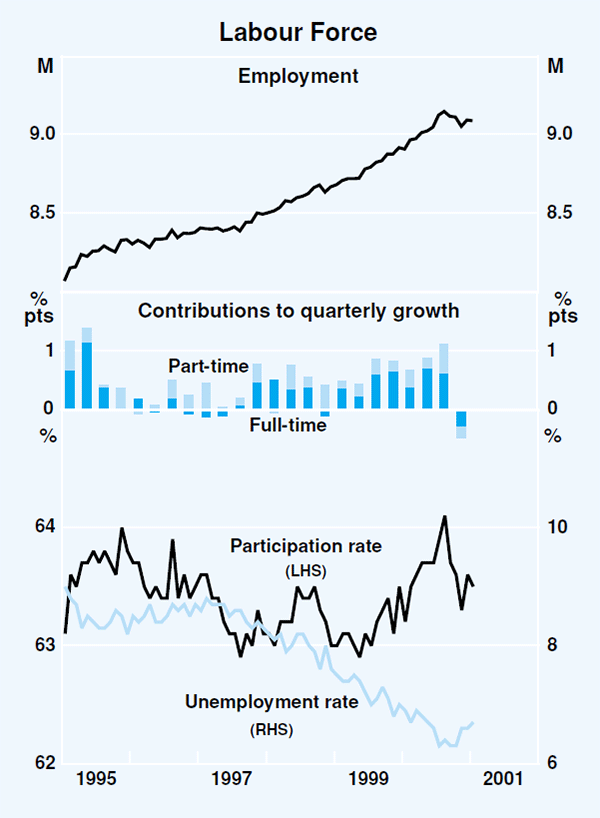
The composition of employment has been affected by the conjunction of the introduction of the new tax system and the Olympic Games. In particular, the strong growth in construction employment over the past couple of years was partly reversed in the second half of the year as activity in that sector declined from its pre-GST peak. Employment has also fallen over the past year in the wholesale trade and manufacturing sectors, whereas it has risen strongly in the service sector, particularly in hospitality and property and business services.
Over the year to the December quarter, most states experienced solid employment growth and declining unemployment rates (Table 7), with particularly rapid employment growth being recorded in Victoria. In the latter part of the year, employment growth slowed in all states except Western Australia and Tasmania. Employment growth over the past year has been stronger in regions outside the capital cities. Consequently, unemployment rates in these areas have generally fallen more rapidly over the past year, but still typically remain higher than in the capital cities.
| NSW | Vic | Qld | SA | WA | Tas | Australia | |
|---|---|---|---|---|---|---|---|
| Employment growth | |||||||
| – Year to Dec quarter 2000 | 2.0 | 3.6 | 1.8 | 0.5 | 1.2 | 2.2 | 2.2 |
| Unemployment rate | |||||||
| – Dec quarter 1999 | 6.0 | 6.9 | 8.2 | 8.2 | 6.6 | 9.4 | 7.0 |
| – Dec quarter 2000 | 5.8 | 6.1 | 7.9 | 7.4 | 6.2 | 8.9 | 6.5 |
Most forward-looking indicators of labour demand suggest that employment growth will remain subdued over the next six months or so. The number of jobs advertised in newspapers has fallen to be around 20 per cent lower than its peak in May 2000, although recently there have been some signs of recovery. The ANZ Bank series increased by 3.7 per cent from November to January, while the index of skilled job advertisements compiled by the Department of Employment, Workplace Relations and Small Business (DEWRSB) recorded a large increase over the same period. The decline since the peak last May has been exacerbated by the trend towards advertising for information-technology professionals on the internet, but the number of advertisements for tradespersons – and for construction workers in particular – has fallen sharply, in line with the decline in construction activity.
The major surveys of business expectations also point to a softer outlook for the labour market (Graph 34). The NAB quarterly survey reported that employment intentions for the March quarter have declined to quite low levels, and the ACCI-Westpac survey indicates that hiring conditions are weak in the manufacturing sector.
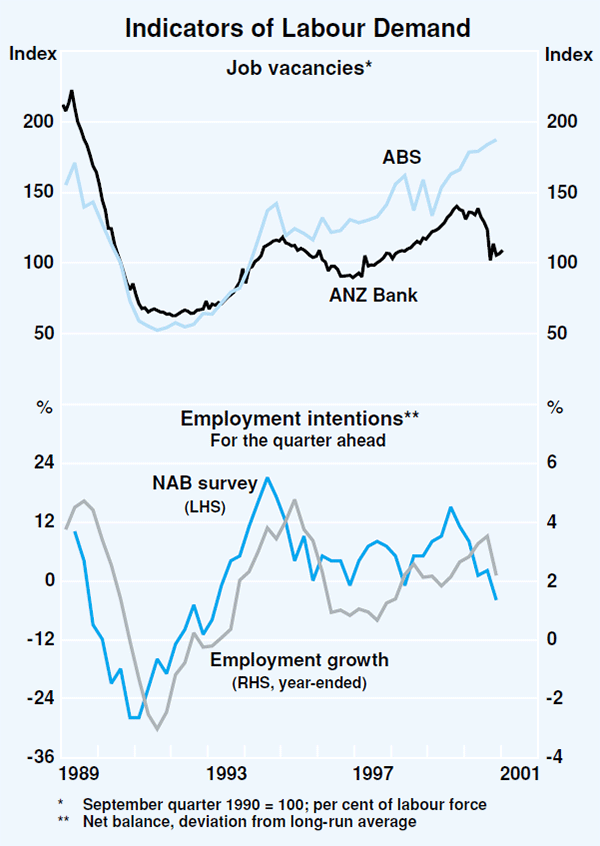
In contrast to the other labour market indicators, the ABS measure of job vacancies has remained much more buoyant. Based on a survey of employers rather than a count of newspaper advertisements, the ABS measure indicates that the number of job vacancies has risen in each of the past seven quarters and in the December quarter, was 14.6 per cent higher than a year earlier. The ABS series has been boosted by strong growth of job vacancies in the property and business services sector, which includes vacancies for IT workers likely to have been missed by counts of newspaper job advertising; in addition, the series has not been as severely affected by the recent contraction in the construction industry.
Box A: Changes in the Timing of Company Tax Payments
Since 1 July 2000, the lag between when a company earns income and when it pays tax on that income has been substantially reduced. Under the new tax system, companies will pay most of their company tax instalments in the financial year in which the liability is incurred. This contrasts with the previous system in which companies (unlike individuals) paid much of their tax after the year in which income was earned. The switch to the new system raises the possibility of larger tax payments this financial year as companies pay tax both on income earned in 1999/2000 (under the old tax arrangements) and income earned in 2000/01 (under the new tax arrangements). However, deferral arrangements reduce this burden markedly in 2000/01 by allowing payments to be spread over a number of years. The deferral arrangements vary according to the amount of tax paid by a company.[1]
Large tax companies
Under the old tax arrangements, large tax companies (those that pay more than $300,000 annually) paid tax in four quarterly instalments: the first two instalments fell due in March and June of the relevant fiscal year, with the remaining instalments in September and December of the next fiscal year (Graph A1, top panel). Under the new arrangements, companies pay corporate tax mainly in the year in which it is accrued: tax is based on quarterly income and is paid three weeks after the end of the quarter (Graph A1, middle panel).
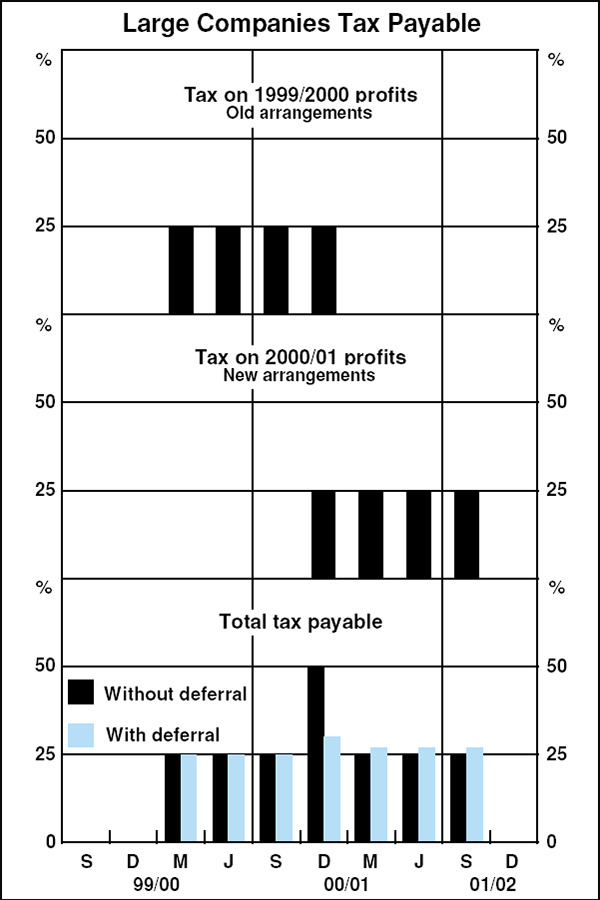
In the absence of the deferral arrangements, a large company would have had to pay about 125 per cent of its normal annual tax bill in 2000/01 – 50 per cent (two instalments) of its annual tax bill for 1999/2000 profits, as well as 75 per cent of the tax bill incurred in 2000/01. Under the deferral arrangements, companies can defer most of the fourth instalment on 1999/2000 profits and pay it in equal quarterly instalments over the next 2½ years. A company making full use of the deferral provisions might expect to pay about an extra 10 per cent of its normal tax bill in 2000/01.
Medium tax companies
Previously, medium tax companies (companies that pay between $8,000 and $300,000 tax per year) paid the first quarterly tax instalment in the June quarter of the relevant fiscal year (a quarter later than large companies), with the subsequent three quarterly instalments paid in the following financial year (Graph A2, top panel). The new arrangements bring this tax payment schedule forward by about seven months. However, the deferral arrangements allow companies to defer the third instalment on 1999/2000 profits and most of the fourth instalment, with these payments to be made over the next five years. As a result, the total tax bill for a medium-sized company in 2000/01 will be around 10 per cent more than in a normal year.
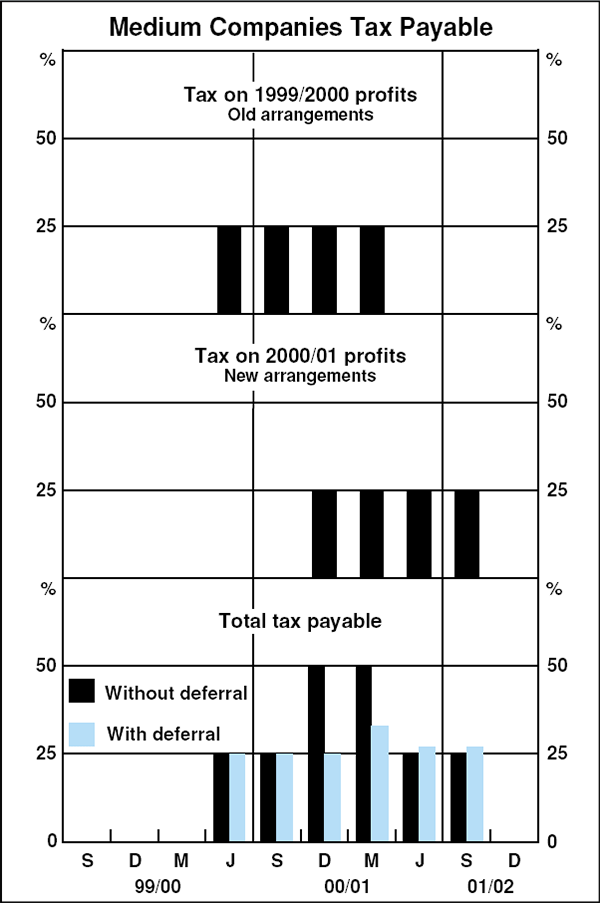
Small tax companies
Small tax companies (companies that pay less than $8,000 per year) represent over 80 per cent of the number of corporate taxpayers, although they account for only 3 per cent of corporate tax collected. Under the old arrangements, these companies made one annual tax payment in December in the fiscal year following that in which profits were earned (Graph A3, top panel). The new arrangements require quarterly tax payments for small tax companies that are registered for the GST. (Small tax companies that are not registered for the GST can continue to make annual payments.) Without the deferral arrangements, small companies would have been required to pay, during the 2000/01 fiscal year, all of the tax on profit earned in 1999/2000, plus three quarterly instalments based on 2000/01 profits. Small tax companies have been permitted to defer all of the tax on profit earned in 1999/2000 which was due in December 2000, and pay it in quarterly instalments over five years from April 2001. A company which fully used the deferral provisions would pay around 20 per cent less tax in 2000/01 than in a normal year.
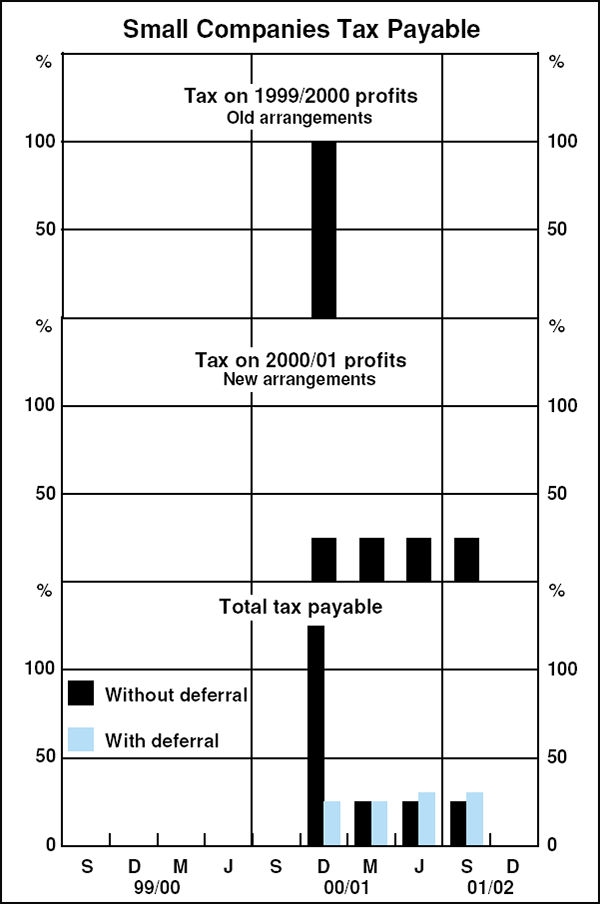
Balance of Payments
Strong trading partner growth, the lower Australian dollar and the Olympics all continued to support Australia's external accounts during the second half of 2000. From the recent peak of nearly 3 per cent of GDP, reached in September 1999, the quarterly trade deficit narrowed to around ½ of one per cent of GDP in the December quarter 2000. The staging of the Olympics and the Paralympics obviously contributed to this outcome, and according to the ABS, boosted exports by around 0.9 per cent of GDP in the September quarter and 0.1 per cent of GDP in the December quarter. After abstracting from these events, however, it is still clear that the trade balance has narrowed considerably, driven by continued strong growth in exports and some moderation in imports (Graph 35).
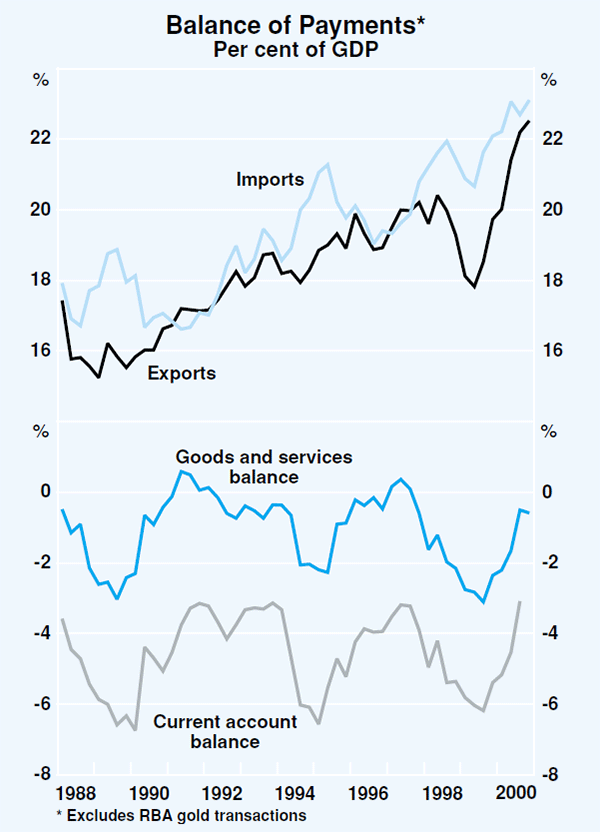
The value of exports increased by over 4 per cent in the December quarter and was 27 per cent higher than a year earlier (abstracting from the effect of the sale of a frigate in the December quarter 1999). The lower exchange rate ensured that prices in Australian dollar terms contributed to the quarterly rise. Export growth has been strong to all major destinations over the past year, with particularly strong growth to east Asia and Japan (Graph 36). Much of the increase in the value of exports to east Asia and Japan has been in resources, although service exports to this region also rose considerably in the December quarter, following weakness in the peak Olympic period.
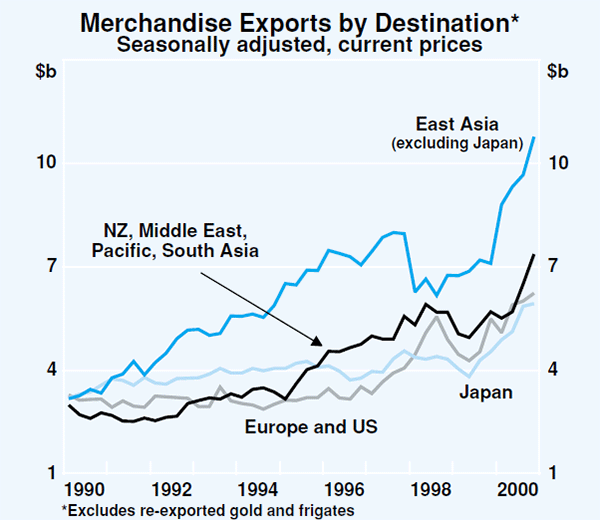
Resources exports have been the fastest growing export category over the past year, and this continued into the December quarter. Over the year to December, resource export earnings increased by 45 per cent, excluding re-exported gold. Although higher prices have contributed to some of this increase, the quantities of mineral fuels, metals and other non-rural goods exported have also risen strongly, in several cases as a result of new production coming on stream. The increase in mineral fuel exports has been most pronounced for crude oil, where quantities exported have risen by over 50 per cent over the last year and have nearly doubled over the last two years.
Earnings for rural exports rose modestly in the December quarter, driven by higher prices. The value of greasy wool and meat exports both increased as a result of strong external demand and higher production, but the rise was offset by lower values of cereal exports. In the near term, the quantity of rural exports is likely to be adversely affected by the unfavourable climatic conditions experienced recently. The Australian Bureau of Agricultural and Resource Economics estimates that the volume of total farm production will be 4.6 per cent lower in the current fiscal year, due to the recent drought in Western Australia and floods in the eastern states.
Service exports fell in the December quarter, following the Olympics-related boost in the September quarter. The ABS estimates that the Olympics and Paralympics added $1,400 million to service exports in the September quarter and $160 million in the December quarter. Excluding the direct effects of the Olympics, the value of service exports grew by about 4 per cent in the quarter, to be over 15 per cent higher over the year, driven largely by increased tourism receipts. Although the Olympics seemed to displace some tourism from Japan, New Zealand and parts of east Asia, arrivals from these regions have since recovered, while the strong growth in the number of visitors from the US and EU has moderated.
Manufactured exports rose further in the December quarter, to be 20 per cent higher over the year (excluding frigates). It is possible that the modest easing in growth in the latest quarter reflected the moderation in global growth that has taken place, although the current level of the exchange rate implies that manufactured exports remain very competitive. Over the past year, growth has been spread across most major components of manufactured exports. Exports of telecommunications goods, while volatile, have been at a high level. Growth in manufactured exports has been quite widespread across all major destinations.
The value of imports grew only slightly in the December quarter and was generally weak during the second half of 2000. This was consistent with both the significant depreciation of the currency during the year and the moderation in domestic demand growth that has taken place. Of these two influences, the exchange rate has probably been the more significant, as it has contributed to an increase in the import price index by around 15 per cent over the past year.
Weakness has been evident across each of the major categories of imports, and has been particularly noticeable for imports of capital goods. Some components, however, have continued to grow strongly. Changes to the tax system, for example, contributed to a 30 per cent rise in the quantity of motor vehicles imported over the year to December. Telecommunications equipment imports also continued to grow strongly in December, with mobile phones accounting for about half of the quarterly increase.
The continued strong demand for imported telecommunications equipment is contributing to the ongoing rise in the share of imports from east Asia (excluding Japan) (Graph 37). Overall, the value of imports from this region rose by $1.8 billion over the year to the December quarter. Computer and telecommunications imports accounted for about a third of the increase, and petroleum for a further quarter.
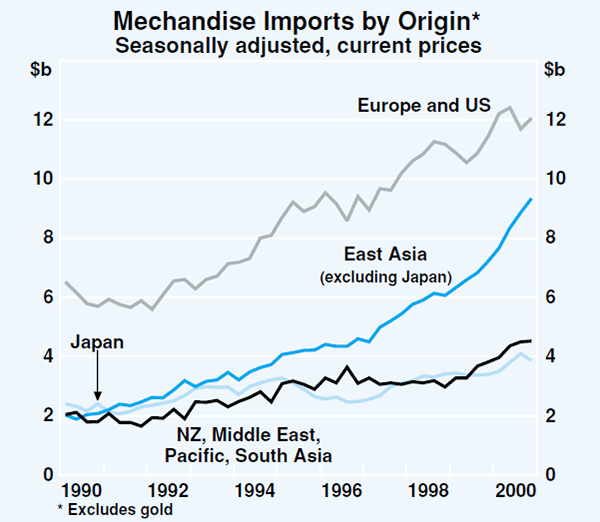
The net income deficit has continued to narrow, falling from 3.2 per cent of GDP a year ago to 2.6 per cent of GDP in the September quarter. Combined with the recent strong growth in exports, this narrowing has implied that the ratio of net income payments to exports has fallen to around 12 per cent, its lowest level since the early 1980s.
Australia's net foreign debt increased by 9.6 per cent in the September quarter to $294 billion, or 46 per cent of GDP. There were sizeable net debt inflows to the private sector and the depreciation in the Australian dollar increased the measured Australian dollar value of external debt. Net equity liabilities fell, largely due to the depreciation increasing the value of equity investments abroad in local currency terms. Net equity inflows have been fairly weak since September 1999, especially relative to the preceding two years, reflecting both lower inflows and greater participation in offshore equity markets by Australian investors. Overall, net foreign liabilities increased by 3.6 per cent in the September quarter to around 63 per cent of GDP.
Commodity prices
Commodity prices increased significantly in the first half of 2000, but, in foreign-currency terms, growth weakened during the second half of the year; over the six months to January, the Bank's commodity price index increased by around 2 per cent to be 8 per cent higher than a year earlier (Graph 38). All major components of the index increased a little over the past six months. Oil prices have remained volatile.
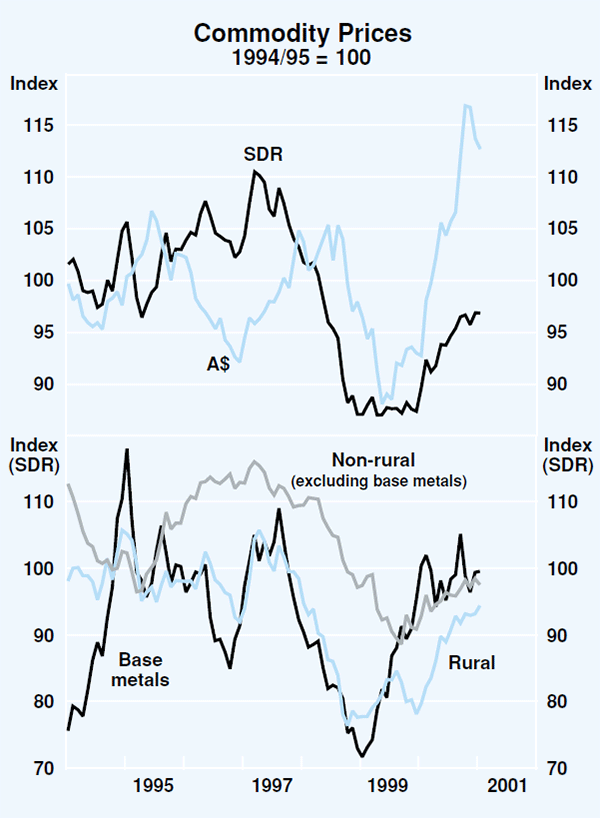
The movements in the exchange rate over the past year, however, implied that in Australian dollar terms, commodity prices reached record levels by historical standards early in the December quarter. Although some of these gains were subsequently retraced, they remain nearly 20 per cent higher over the year.
The increase in rural prices over recent periods largely reflected concerns that unfavourable weather conditions in Australia and some other parts of the world would restrict the supply of rural commodities. Wheat prices increased particularly strongly in the December quarter, by over 15 per cent in SDR terms. Wool prices, in foreign-currency terms, were weak early in the December quarter, due to a run-down in the wool stockpile and reports of higher production, before recovering quite strongly to be around 12 per cent above the levels prevailing a year ago.
Most non-rural commodity prices, other than base metals, also rose during the December quarter, although gold prices remained soft. The price of gold in SDR terms fell by around 1 per cent. Coal prices have increased particularly strongly in recent periods, driven by persistently firm demand from Asia and tight supply in the region. Over the December quarter, prices received for coal increased by around 8 per cent in US dollar terms, to be 24 per cent higher than a year earlier.
Base metal prices weakened early in the December quarter, before falling inventory levels led to some recovery. In January, however, they were a little below levels recorded a year earlier. Aluminium prices fell by around 2 per cent in the December quarter. Although the prospect of slower global growth placed downward pressure on prices, the relatively high oil price fuelled expectations of higher aluminium production costs and lower supply. Copper and lead prices firmed slightly in January on perceptions that global inventories are quite low.
Oil prices have varied considerably in recent months. The price of West Texas Intermediate crude oil was above US$30/barrel until early December, but it then fell sharply to finish the December quarter about US$3/barrel lower (Graph 39). Throughout this period, the price of oil was held up by intermittent military tensions in the Middle East, forecasts of cold weather in the Northern Hemisphere, and low oil inventory levels. OPEC's production increase in October did little to ease prices because it was thought unlikely to match projected increases in global demand. The US release of 30 million barrels from emergency reserves in November was more effective; it boosted US inventory levels noticeably at a time when they usually fall. Oil prices dropped markedly in response to this. Since early January, prices have recovered somewhat, following OPEC's decision to cut target production by 1.5 million barrels which partially unwinds the 3.7 million-barrel increase over 2000. Oil is currently priced at around $US30 per barrel.
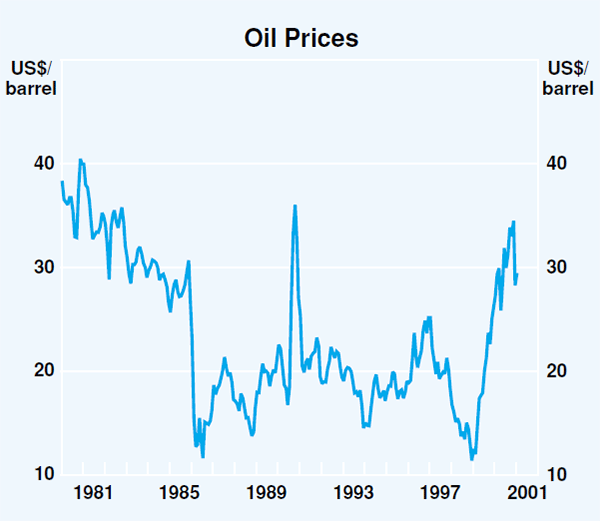
Domestic Financial Conditions
In response to the strength of domestic demand conditions during much of 1999 and 2000, and the consequent risks to inflation, monetary policy was tightened in a series of steps between November 1999 and August 2000. The increases in short-term interest rates in that period are likely to have reduced scope for discretionary expenditures and therefore to have exerted a dampening influence on domestic demand during the year. The size of the overall interest rate increase, however, was relatively mild in terms of recent historical experience, with rates rising from a below-average position in late 1999 to levels that were close to, or still slightly below, their average for the low-inflation period (i.e. the period since 1992).
In assessing the overall impact of financial conditions on the economy it is also important to take account of a broader range of variables including developments in the financial aggregates, share prices, capital markets and the exchange rate. Share markets in Australia have held up considerably better than has been the case in other countries, notably the US. Credit growth in Australia has been quite strong over the past year and, while it has slowed in recent months, remains readily available to households and businesses. Businesses have also continued to have good access to internal funding and to direct financing from capital markets. At the same time, the lower value of the Australian dollar over the past year has been providing a strong boost to the export sector. These developments are analysed in more detail below.
Interest rates
By August 2000, the nominal cash rate had increased by 1½ percentage points since the start of the recent series of policy tightenings, to 6¼ per cent, a level marginally above its average during the low-inflation period (Graph 40). Because the variation in core inflation during this period was relatively small, conducting the analysis in terms of the real interest rate makes little difference to that conclusion (see Box B for a more detailed analysis).
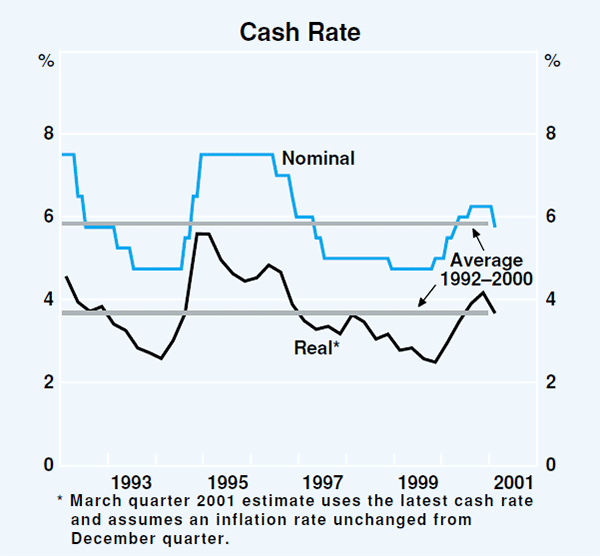
While the cash rate is the interest rate in which the stance of policy is expressed, the more relevant rates for judging the impact on the economy are the rates that borrowers pay financial intermediaries. As set out in more detail in Box B, the conclusion that recent levels of real interest rates have not been particularly high is stronger if the comparison is made using intermediaries' interest rates. The sharp compression in banks' interest margins over the past five years or so has meant that the December quarter level of mortgage rates, for example, was noticeably below its average for the low-inflation period, in both nominal and real terms. Mortgage rates at end 2000 were also at a lower level than at the cyclical low reached after the early 1990s recession. As discussed in the chapter on ‘Domestic Financial Markets’, interest rates on various fixed-rate loans have fallen quite significantly in recent months reflecting declines in rates in capital markets.
Comparing the situation with the US, a couple of important differences are worth noting. The peak in the Federal funds rate in this latest cycle (6.5 per cent) was higher than that reached in the 1994/95 tightening (6 per cent), whereas in Australia the most recent peak in the cash rate was well below the mid 1990s peak (6.25 per cent vs 7.5 per cent). A similar conclusion would apply if the comparison had been made using real rates of interest. Tables 8 and 9 give more details of Australian and US interest rates.
| Cash rate |
Mortgage rate (standard variable) |
Small business indicator rate |
|
|---|---|---|---|
| Nominal rates | |||
| Dec 2000 | 6.25 | 8.05 | 9.20 |
| Average 1992–2000 | 5.85 | 8.56 | 9.53 |
| Real rates(a) | |||
| Dec 2000 | 4.17 | 5.93 | 7.06 |
| Average 1992–2000 | 3.69 | 6.34 | 7.29 |
| (a) Real interest rates calculated using the weighted median inflation rate. An inflation rate of 2¼ per cent was used for the September quarter 2000 and 2 per cent for the December quarter 2000. | |||
| Federal funds rate |
Mortgage rate |
Business indicator rate |
|
|---|---|---|---|
| Nominal rates | |||
| Dec 2000 | 6.50 | 7.38 | 9.50 |
| Average 1992–2000 | 4.88 | 7.76 | 7.84 |
| Real rates(a) | |||
| Dec 2000 | 3.82 | 4.68 | 6.74 |
| Average 1992–2000 | 2.08 | 4.89 | 4.96 |
| (a) Real rates calculated using core inflation. | |||
Another measure of the tightness or looseness of domestic financial conditions is the shape of the yield curve – specifically, the relationship between short-term rates, which are set by the authorities, and long-term rates, which are determined in the market. If short-term rates are higher than long-term rates, this is sometimes taken to indicate that monetary conditions are relatively tight.
Such a situation has developed in Australia over the past few months. Before the recent easing, yields on 10-year bonds had fallen to 5.25 per cent, 100 basis points below the then cash rate (Graph 41). This was the first inversion of the yield curve in Australia since the late 1980s, although that was much greater in magnitude and was caused by a very sharp rise in the cash rate, whereas the latest episode mainly reflects falling long yields. The latest episode is more like the situation in 1998, when long yields also fell sharply as markets became pessimistic about the economic outlook (although subsequent events proved those concerns to be unfounded).
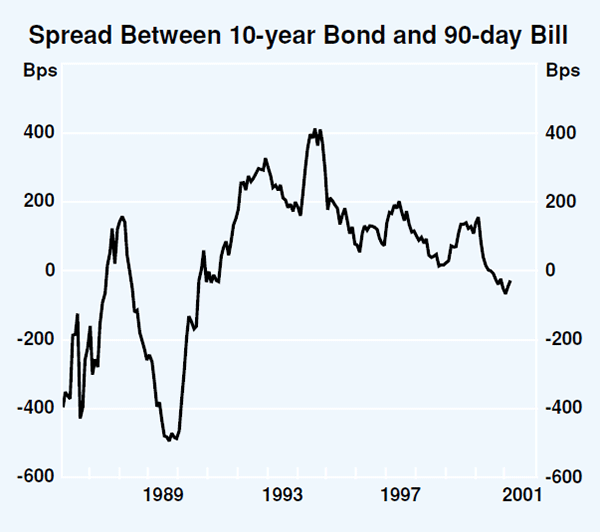
Financial aggregates
Since the mid 1990s, credit has grown at a solid rate, ranging between about 8 per cent and 15 per cent (Graph 42). Growth accelerated toward the top of this range in the first half of 2000, partly due to the forthcoming introduction of the GST, which saw housing lending, in particular, rise strongly. Since then, it has slowed, but the current rate of 8¼ per cent (on a six-month annualised basis) remains within the range in which it fluctuated during the strong economic expansion over the second half of the 1990s, and much higher than it was in the recession of the early 1990s, when credit growth was negative.
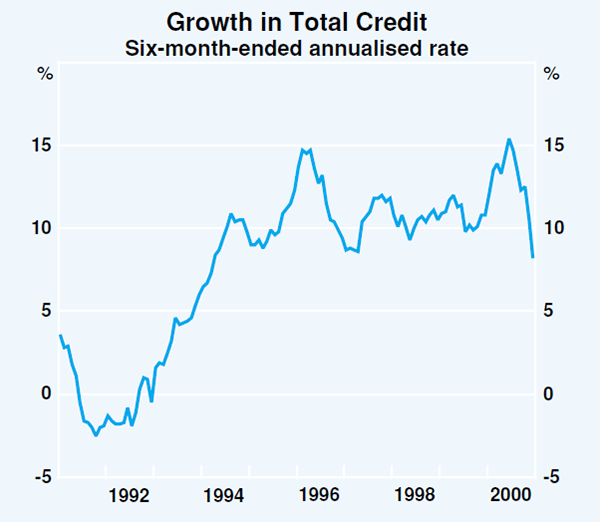
Households continue to borrow at a faster rate than businesses, with housing credit rising at an annual rate of about 11 per cent in the six months to December, and growth in personal credit around 13 per cent over the same period. Growth of business credit has slowed noticeably to about 5 per cent (annual rate) in the six months to December. While there is likely to be some element of cyclical slowdown here, the slowing in borrowing by businesses from intermediaries also seems to reflect high levels of internal funding, as profits remain high, as well as the continuing recourse to direct raisings in capital markets (see the chapter on ‘Domestic Financial Markets’ for further details).
Credit, broadly speaking, is a measure of assets that intermediaries hold on their balance sheets. The monetary aggregates are a measure of domestic liabilities used by intermediaries to fund credit provided to businesses and households. Prior to deregulation, credit and the monetary aggregates used to move similarly, being the opposite sides of intermediaries' balance sheets. But, in recent years, periods of divergent growth have been common as intermediaries found new ways to fund themselves. Over the past four years, the monetary aggregates have been extremely volatile. Recently, the monetary aggregates have slowed sharply (Graph 43). In the six months to December, for example, broad money grew at an annual rate of about 1½ per cent. A gap between the growth of credit and broad money has been evident since 1997 and reflects switching by intermediaries from domestic deposit funding (which is counted in the monetary aggregates) to foreign sources of funds (which are not).
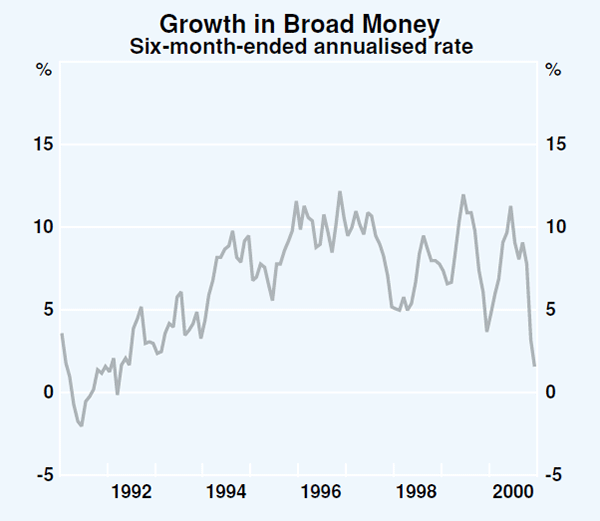
The pattern of funding of intermediaries' balance sheets over the past six months is summarised in Table 10. In recent months, they have relied on foreign raisings to fund almost 60 per cent of the rise in credit; about a further 10 per cent has been funded in domestic capital markets through domestic bond issues to take advantage of the low level of long-term interest rates. (Issues of bonds by banks are also excluded from monetary aggregates.) Only about a third of new funding in the second half of 2000 came from banks' traditional source of funds, namely raising deposits in domestic markets. The result has been that recent growth in domestic deposit liabilities has fallen by noticeably more than the overall level of financing activity in the economy, of which credit is the best measure.
| Liabilities | Assets | ||
|---|---|---|---|
| Deposits | 11.8 | Credit | 33.6 |
| Net offshore raising | 19.4 | ||
| Domestic bonds | 3.4 | ||
| Net other liabilities | −1.0 | ||
| Total | 33.6 | 33.6 | |
Real exchange rate
As discussed in detail in the chapter on ‘International and Foreign Exchange Markets’, the Australian dollar fell sharply during 2000, both against the US dollar and in trade-weighted terms. Since inflation rates in Australia and in most major trading partners have remained comparably low in recent years, these movements in nominal exchange rates also translate into measures of real exchange rates, which adjust for differences in inflation rates across countries. Graph 44 shows a measure of the real trade-weighted index of the Australian dollar obtained by adjusting the component bilateral rates for relative movements in consumer prices. This index fell by around 11 per cent over the year to the December quarter, in line with the movement of the nominal TWI.
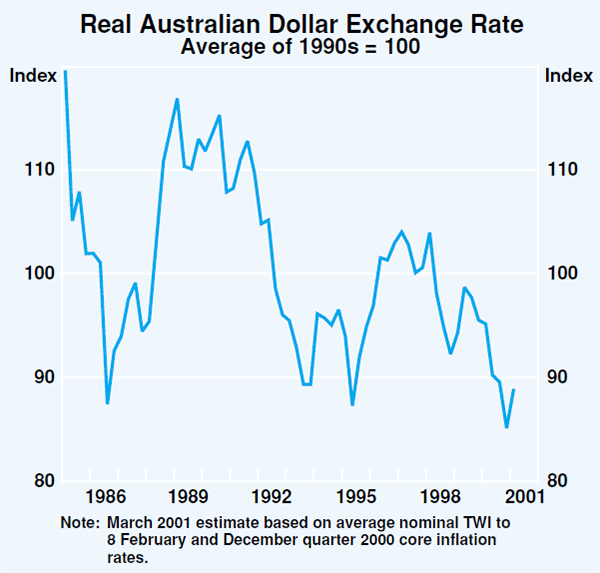
While it is not possible to establish any exact benchmark for evaluating the influence of the exchange rate on the economy, recent levels of the real exchange rate have been clearly at the low end of historical experience, and therefore exerted an overall expansionary impact. The real TWI in the December quarter was 15 per cent below its 1990s average, and slightly lower than previous quarterly troughs recorded in 1986 and 1995. The appreciation in the nominal exchange rate in recent weeks will have reversed only a small part of this stimulus.
Box B: Real Interest Rates
Interest rates are often analysed in real, or net of inflation, terms. This takes account of the fact that part of the nominal interest that borrowers agree to pay to lenders represents compensation for anticipated inflation. The remaining ‘real’ component better reflects the economic cost of borrowing and the return to lending.
There are a number of measurement issues that arise in calculating real interest rates. There is no unique measure of this concept because interest rates vary depending on such factors as the maturity and risk of the loan or asset. Another important issue is that measures of real interest rates should ideally be constructed from expected inflation over the life of the loan or asset. In practice, however, inflation expectations are not readily observable, and they have to be proxied either by survey-based measures or by an appropriate indicator of the current actual inflation rate. For these reasons it is important to look at a range of measures when assessing the overall impact of real interest rates on incentives to borrow and invest.
Graph B1 shows two measures of the real cash rate. The first is calculated using a measure of current inflation (the weighted median inflation rate[1] over the year to the time the cash rate is observed) and the second using a measure of expected inflation (the Melbourne Institute survey of households' inflation expectations). The real cash rate calculated on the second basis is consistently the lower of the two, because the survey measure of consumers' inflation expectations has typically exceeded actual inflation.
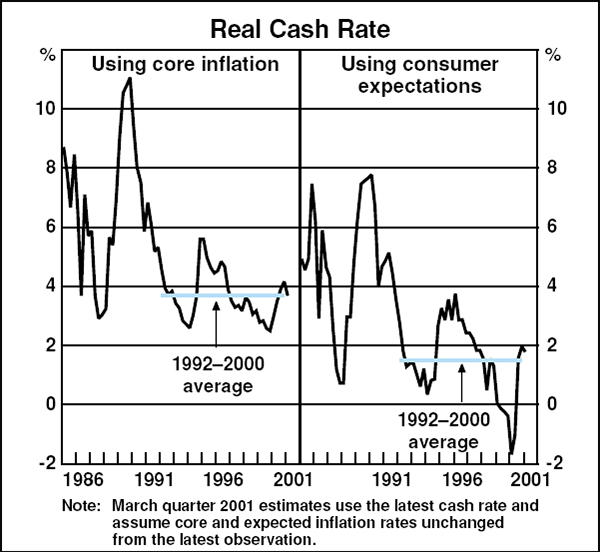
The real cash rate measured using current inflation rose by around 1¾ percentage points from the trough at the end of 1999 to the December quarter 2000. This measure implied a real cash rate of just over 4 per cent prior to the February policy easing, only slightly above its average for the low-inflation period since 1992. The second of the two measures has shown a somewhat different pattern over the past year. It declined sharply during 1999 and into the early part of 2000, reflecting the temporary upward spike in consumers' expectations of inflation prior to the introduction of the GST. Subsequently, as inflation expectations have returned to more normal levels, the implied real cash rate has moved back up. Nevertheless, this measure too rose to a level only marginally above its average for the period since 1992. Both these measures of the real cash rate remain well below the levels reached in the mid 1990s tightening phase of monetary policy, which in turn were significantly below the peaks reached in the late 1980s.
Graph B2 shows real interest rates of financial intermediaries for housing and small business loans, calculated using current inflation rates (corresponding to the first of the two methods described above). While broadly tracking movements in cash rates in the short term, these indicator rates have undergone a significant downward shift relative to cash rates in the course of the past decade, reflecting the competitive pressures that have compressed intermediaries' net interest margins over that period. Hence, while intermediaries' real indicator rates for these types of loans have increased during the past year in line with the cash rate, they are still relatively low in historical terms. Before the February easing, real housing loan rates were just under 6 per cent, about half a percentage point below the average levels over the low inflation period since 1992, and lower than they were at their cyclical trough in the early 1990s. The compression of margins on business indicator rates has not been quite as pronounced as has been the case for housing loans in that period, but these rates also were slightly below their cyclical average in real terms in December.
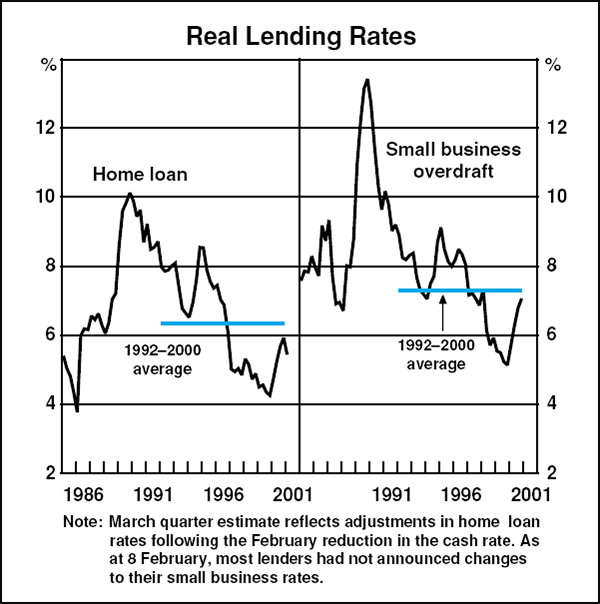
Domestic Financial Markets
Market interest rates
For some time following the tightening of monetary policy early in August, market participants continued to expect further monetary tightening. Reflecting this, the yield on 90-day bills rose to a peak of 6.65 per cent in late September (Graph 45). These market expectations subsequently gradually subsided, but bill yields remained above the cash rate through to end November.
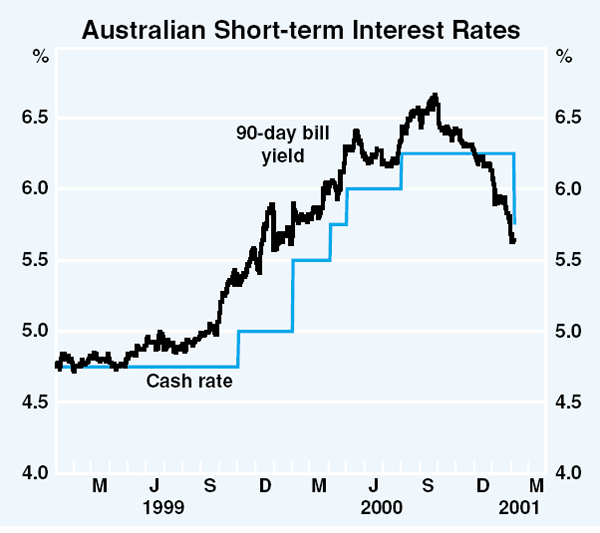
In mid December, the situation began to change. There was growing concern about instability in US asset markets and the possibility of a slowing in the US economy. Markets in the US began to expect that the Fed would ease interest rates by its late January meeting. While commentators drew a sharp distinction between Australian and US developments, the building expectations of a US easing did start to have some impact on local markets. By late December, short-term yields in Australia had moved a little below the cash rate, but this process gathered momentum after the cut in the US Fed funds rate early in January and, again, after the favourable domestic inflation news later in the month. By early February, financial markets had largely anticipated the cut in the cash rate of 0.5 of a percentage point (to 5.75 per cent) on 7 February, so that short-term yields showed little further change.
Long-term market yields in Australia have also moved sharply lower in recent months. They had traded within a range of 6 and 6¼ per cent for much of the second half of last year. From mid November, however, they began to fall, mainly, at first, on the back of the fall in yields in the US. Bond yields in Australia continued to fall in January, however, even though they rose from their lows in the US after the Fed's move. By early February, the yield on Australian 10-year bonds had moved down to about 5.25 per cent, its lowest level since April 1999, when yields were rising from the historical lows associated with the near collapse of the hedge fund LTCM (Graph 46).
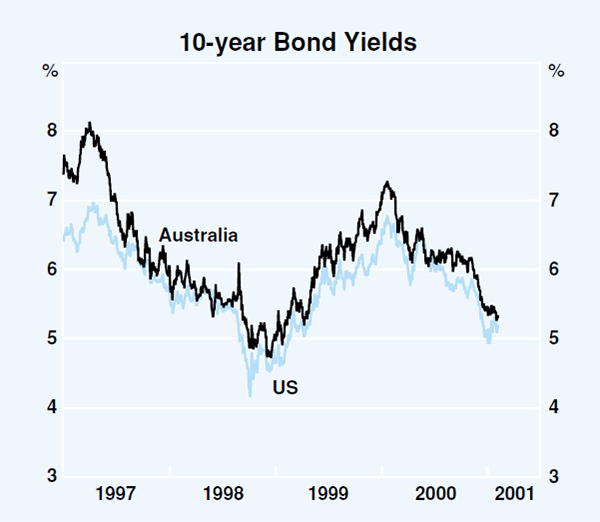
Over the past few years, Australian bond yields have shown a very high correlation with US yields, more so than the correlation of short-term interest rates in the two countries. It is therefore hard to know the extent to which the recent fall in domestic bond yields is simply a reflection of US developments. More generally though, the fall in bond yields in Australia is set against a background of falling inflation expectations.
The differential between Australian and US 10-year bonds has remained within a tight range in recent months, between zero and 50 basis points (Graph 47). In early February, this differential was about 15 basis points, at the low end of the recent range and very low by historical standards.
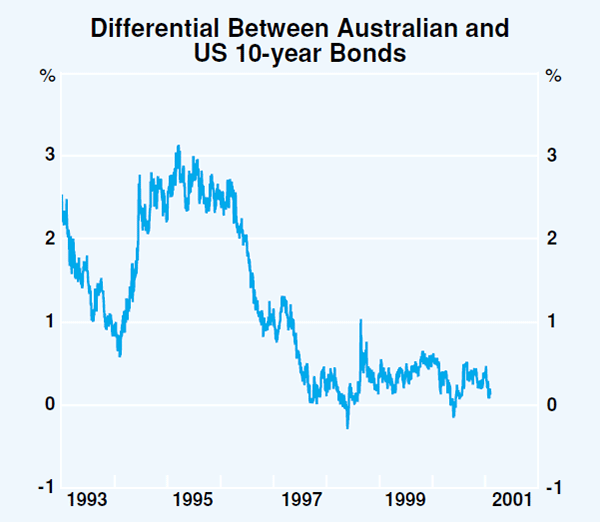
Intermediaries' interest rates
Interest rates on the full range of variable-rate loans to households and businesses remained largely unchanged between the adjustments that followed the last increase in the cash rate in August 2000 and the reduction of 50 basis points in the cash rate in February 2001 (Graph 48). (There were, however, cuts in banks' ‘honeymoon’ mortgage rates of between 0.5 and 1.0 percentage point.)

On the same day that policy was eased in February, each of the major banks (and some other lenders) announced that they would cut their standard home loan rates by the full 50 basis points. The average variable-rate mortgage rate is now 7.55 per cent.
At the time of writing, only one bank had announced a reduction (of 50 basis points) in its variable-rate loans to businesses.
There have been widespread reductions in interest rates on fixed-rate loans in recent months. Since November, banks have lowered the interest rate on 3-year fixed rate mortgages by 0.8 of a percentage point to 6.9 per cent.
The comparable fixed-rate indicator for small businesses has been reduced by slightly more than housing rates recently. The drop in these rates since their peak in early 2000 has been larger for small businesses (at 2.0 percentage points) than for households (at 1.1 percentage points) mainly because small business rates rose by more than mortgages when market interest rates were rising in 1999. The drop in small business fixed rates from the peak has kept pace with the fall (of about 1.9 percentage points) in yields in capital markets in which term loans are funded (Graph 49). About 20 per cent of the stock of housing loans and about 40 per cent of small business loans are at fixed rates.
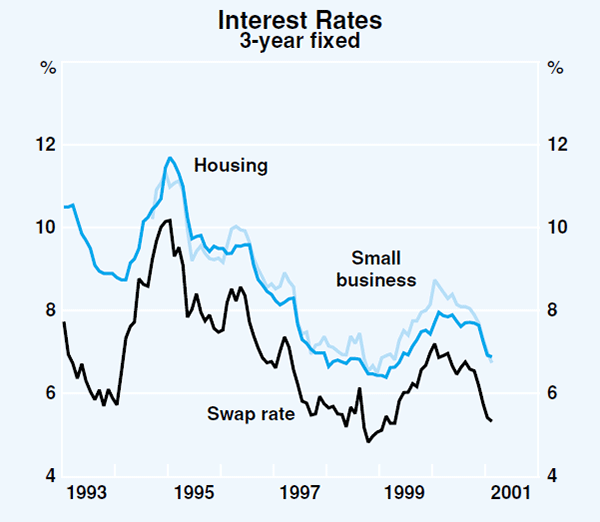
Capital markets developments
Debt markets
Funding through capital markets is becoming an important source of credit. About one-fifth of debt financing used by Australian businesses now comes from capital markets. While this proportion is a lot less than in the US (where around half of business debt financing comes from capital markets), capital market developments are nonetheless an important influence on the availability of credit to borrowers in Australia.
Unlike in the US, there are no signs in Australia of any tightening in access to funds from capital markets. In the December quarter, net total debt raisings amounted to $5 billion, roughly in line with the average quarterly amount raised in the first three quarters of the year.
Corporate bond issuance in Australia in the first half of 2000 was dominated by recently privatised utilities (such as electricity distributors and airports) whose bonds had extra credit enhancements built-in allowing them to be AAA-rated. More recently, a greater share of issuance has come from less highly-rated companies. The move down the credit risk spectrum has been accompanied by an increase in the share of issuance being shorter term (around three years) and floating rate. For the year as a whole, the distribution of raisings by credit rating of the borrower and by maturity was quite even (Table 11).
| By rating | By maturity | ||
|---|---|---|---|
| Credit rating |
Share of total (per cent) |
Maturity (years) |
Total (per cent) |
| AAA | 47 | 1 to 3 | 19 |
| AA | 6 | 4 to 5 | 24 |
| A | 34 | 6 to 7 | 20 |
| BBB | 13 | >7 | 37 |
Interest rates on corporate debt in Australia have come down sharply in recent months, and are now down about 1.8 percentage points from a year ago. This has unwound all the earlier rise that had been associated with the tightening of monetary policy. This fall in corporate yields has been very similar to that in government yields. This reflects the fact that credit spreads in Australia, be they for high-grade or low-grade debt, have not changed much over the past year. For example, spreads on AAA-rated bonds have oscillated between 45 and 55 basis points since June 2000. This stands in marked contrast to US developments (see chapter on ‘International and Foreign Exchange Markets’) and suggests there has been no deterioration in debt market conditions in Australia. The level of non-government yields is shown on Graph 50 while the spreads to government yields are on Graph 51.
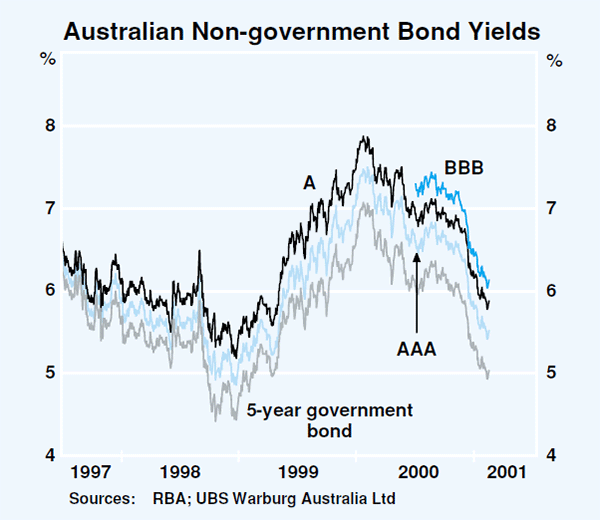
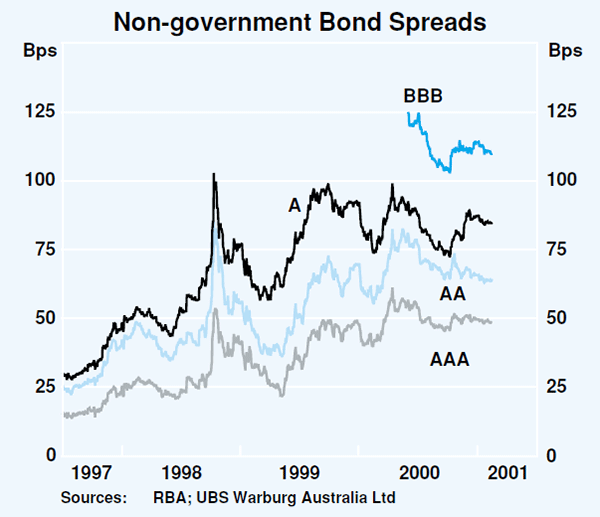
With credit spreads in Australia remaining steady and those in the US rising, the interest rates paid by Australian companies are now significantly below those paid by US companies. Table 12 summarises the relevant interest rates for companies of various credit ratings. The gap for less highly-rated companies is particularly wide.
| Credit rating |
Australia (per cent) | US (per cent) | Margin (basis points) |
|---|---|---|---|
| Government debt | 5.05 | 4.90 | 15 |
| AAA-rated | 5.60 | 5.90 | −30 |
| A-rated | 5.95 | 6.45 | −50 |
| BBB-rated | 6.20 | 7.10 | −90 |
The one area in Australia where there has been some re-rating of risk by markets has been in the telecom sector. This has been a common experience around the world. The international deterioration began around the middle of last year after telecom companies were seen to have paid excessive amounts for so-called third generation (3G) spectrum licences. To finance the acquisition of these licences, the telecommunications sector raised large amounts of debt in corporate bond markets. The growth in that debt, combined with uncertainties about how much additional revenue 3G technology will generate, has seen the credit ratings of telecommunications firms fall and their credit spreads rise.
While Telstra debt has been affected by this, the deterioration in its spread has not been as marked as that for telecoms in some overseas countries (Graph 52). Telstra remains at the better end of the spectrum for credit ratings of telecommunication companies.
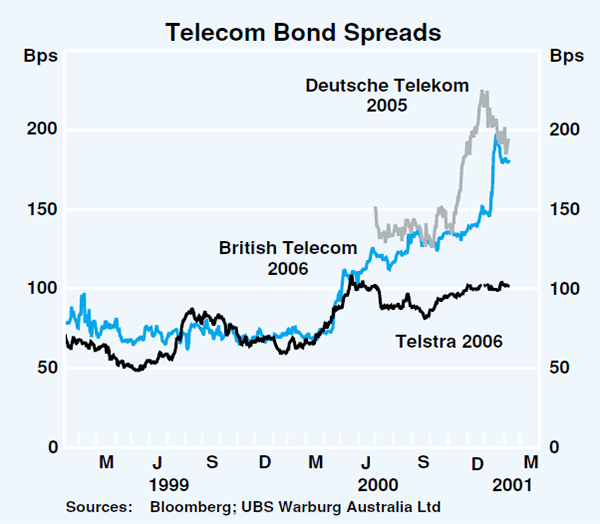
One sector where there is a particularly marked contrast between the Australian and US experience is banking. Spreads on US bank debt relative to government debt rose to over 100 basis points in late 2000 from 60 a year ago. In contrast, the spread on Australian bank debt has remained flat, averaging around 60 basis points (Graph 53). The gap between the spreads widened significantly around the middle of last year, with the collapse in the high-tech equity bubble, as markets became increasingly concerned about the extent to which US banks were exposed. More recently, the policy action by the Fed seems to have calmed markets and US spreads have fallen somewhat.
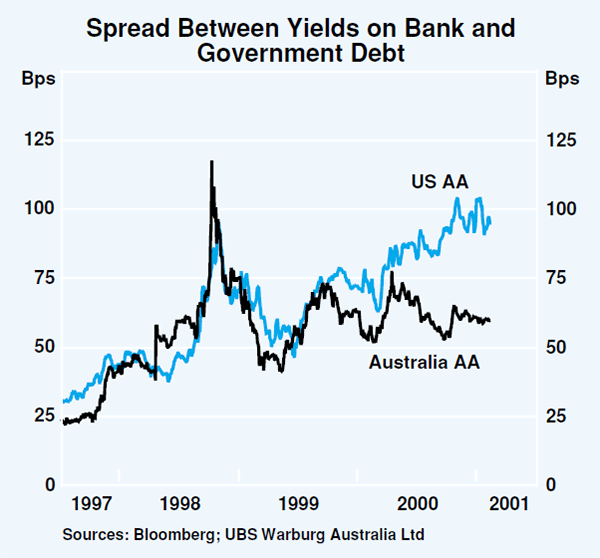
Differences in market assessments of Australian and US banks can also be seen in equity markets, as shown in Graph 54. Share prices of Australian banks are at historical highs but those of US banks are still well down on their level of 1998.
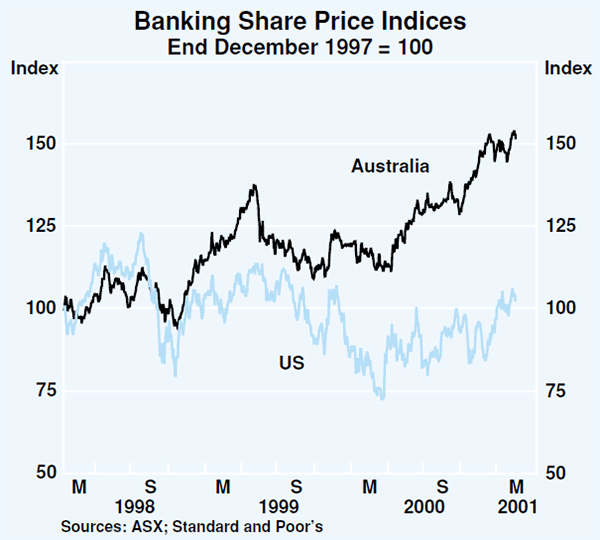
Equity markets
The recent falls that have characterised US share markets have not been reflected in the Australian market. The ASX 200 index has shown little net change since end September whereas the broad-based US indices have shown net falls of around 9 per cent in this period. While share prices in most other developed countries have also held up better than the US market recently, the Australian market is the only one that remains close to its peak.
The recent better performance of the Australian market has allowed it to narrow the gap to the US market that had opened over the past three years (Graph 55). If the comparison is extended back to the start of 1995, of course, the increase in the US share market greatly exceeds that in Australia (the respective increases being around 175 per cent and 70 per cent).
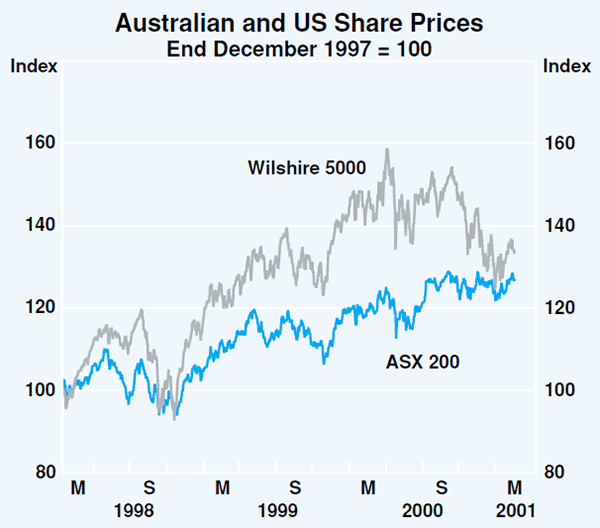
The main sector accounting for the recent relative strength of the Australian market is the banking sector, where share prices have risen by 13 per cent over the past four months. In addition, the resource sector has also been comparatively strong, rising by 5 per cent.
The pure technology sector in Australia has seen a fall in share prices similar to that in the NASDAQ, but this is only a very small part of the Australian index.
Share market valuations remain above average in Australia, though less so than in the US. The commonly used measure of share market valuations – the price-earnings ratio – rose in Australia from around 15 in early 1995 to 29 in mid 2000. Since then, it has fallen back to 21 (Graph 56). This fall has come about not from falls in share prices, as in some other countries, but from rising profits (including the recovery in BHP's and other mining companies' profitability). The long-run average price-earnings ratio in Australia is about 15. As noted earlier, the price-earnings ratio for broad US share indices is currently 25, compared with a long-run average of 16.
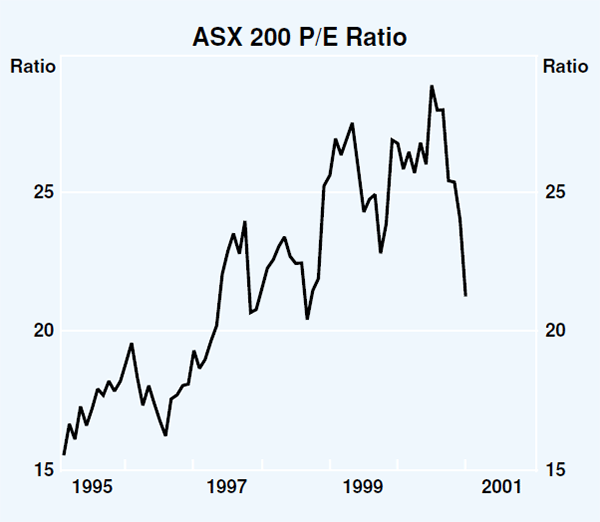
Initial public offerings in Australia slowed in the December quarter 2000 but remain in line with the experience of recent years (Graph 57). The Australian market had not experienced the earlier surge seen in the US, nor has the recent slowing been as marked.
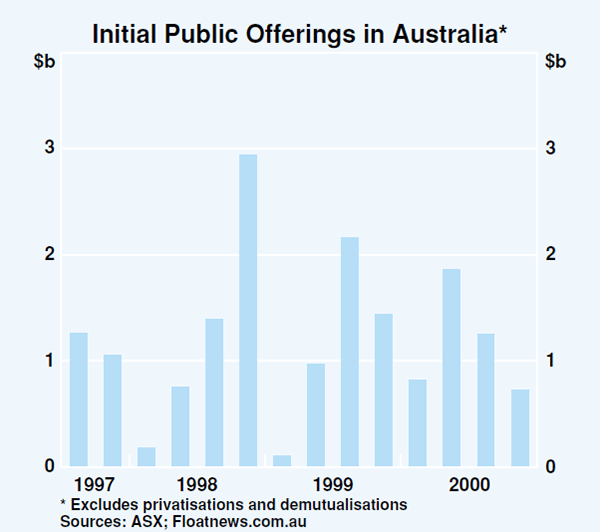
Inflation Trends and Prospects
Recent developments in inflation
Consumer prices
The Consumer Price Index increased by 0.3 per cent in the December quarter, to be 5.8 per cent higher than a year earlier (Graph 58). The December quarter outcome was lower than had generally been expected, and was the result of low outcomes across a wide range of components. Year-ended growth in the CPI and the standard measures of underlying inflation continue to reflect the impact of the new tax system on prices, the bulk of which occurred in the September quarter (Table 13). Higher petrol prices have also significantly boosted the headline CPI. While estimates of the tax effects are subject to considerable uncertainty, the range of available estimates are consistent with underlying inflation (excluding the first-round effects of tax changes and petrol prices) being around 2 per cent over the year to the December quarter 2000.
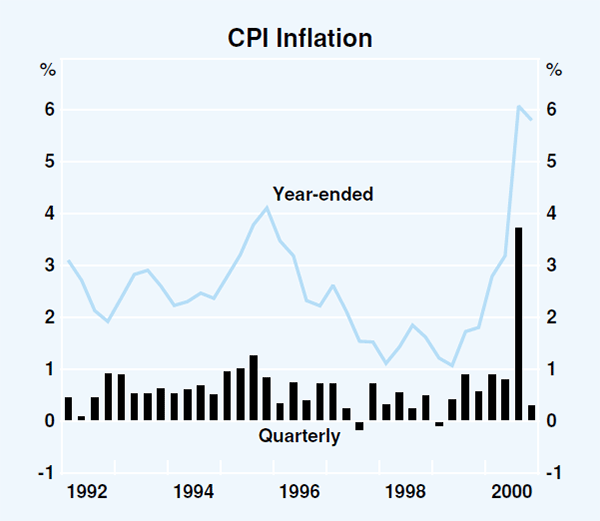
| Quarterly | Year-ended | ||||
|---|---|---|---|---|---|
| September 2000 |
December 2000 |
September 2000 |
December 2000 |
||
| Headline CPI | 3.7 | 0.3 | 6.1 | 5.8 | |
| – Tradeables | 2.1 | 0.2 | 3.4 | 3.8 | |
| – Non-tradeables | 5.1 | 0.5 | 8.4 | 7.6 | |
| CPI excluding volatile items | 3.5 | 0.2 | 5.5 | 5.1 | |
| Market goods and services excluding volatile items |
3.7 | 0.3 | 5.6 | 5.2 | |
| Weighted median(a) | 3.6 | 0.4 | 5.4 | 5.2 | |
| Trimmed mean(a) | 3.9 | 0.4 | 5.9 | 5.8 | |
| (a) For details on the calculation of these measures, see ‘Measuring Underlying Inflation’, RBA Bulletin, August 1994. This is available on our website: <www.rba.gov.au>. | |||||
Prior to the introduction of the new tax system, it was expected that the tax changes would result in a large increase in the CPI in the September quarter, followed by low increases in subsequent quarters as the removal of embedded wholesale sales taxes placed downward pressure on retail prices. In the event, the increase in the CPI over the September and December quarters together was smaller than expected. There are several possible interpretations of this outcome. It is possible that businesses have absorbed some of the tax increase into their profit margins, and are still determining whether to pass these increases on to consumers. In a low-inflation environment, it may take some time for producers to assess the appropriate level of their prices following a widespread change in relative prices, as brought about by reforms such as these. It is also possible that the original estimates of the long-run tax effects were too high. It was always recognised that, given the nature of the tax changes, it was not possible to estimate the magnitude or timing of the net tax effects with precision. Finally, underlying inflation may have been running at a lower rate than had earlier been assessed. All of these factors may be at play to some degree, and it could be another quarter or two before a clearer reading on underlying inflation becomes available.
A couple of non-tax-related factors that had been boosting inflation over the past year abated in the December quarter. Petrol prices continued to contribute to the increase in the CPI, although the 1.3 per cent increase in petrol prices recorded in the December quarter was markedly lower than the increases recorded in the previous few quarters. Over the year to December, the petrol price rose by 24.5 per cent, contributing 1 percentage point to the year-ended increase in the CPI. Over the course of the December quarter, however, petrol prices eased as world oil prices fell and the exchange rate appreciated. Assuming oil prices and the exchange rate remain around current levels, the March quarter CPI is likely to record a fall in petrol prices for the first time since early 1999. Increases in house purchase costs, which have made significant contributions to inflation over the last couple of years, also eased in the December quarter as the housing sector weakened. The house purchase component of the CPI increased by just 0.2 per cent in the December quarter, after having increased by nearly 14 per cent over the year to the September quarter (including tax effects).
The December quarter CPI showed little effect of the depreciation of the exchange rate over the previous year. In import-weighted terms, the exchange rate depreciated by around 11 per cent over the year to the December quarter (Graph 59). Although the lower exchange rate was passed rapidly through to producer and wholesale prices (as discussed further below), as well as retail petrol prices, the pass-through to other consumer prices has been more difficult to detect. Excluding petrol, tradeable prices were flat in the December quarter and increased by 1.9 per cent over the year (including the effect of the tax changes). Imported motor vehicle prices fell by 1 per cent in the December quarter, and prices of other items with a high import content, namely clothing, audio, visual and computing equipment and appliances, either fell or increased very modestly in the quarter. Prices for these goods have either fallen or increased at relatively low rates over the past year.
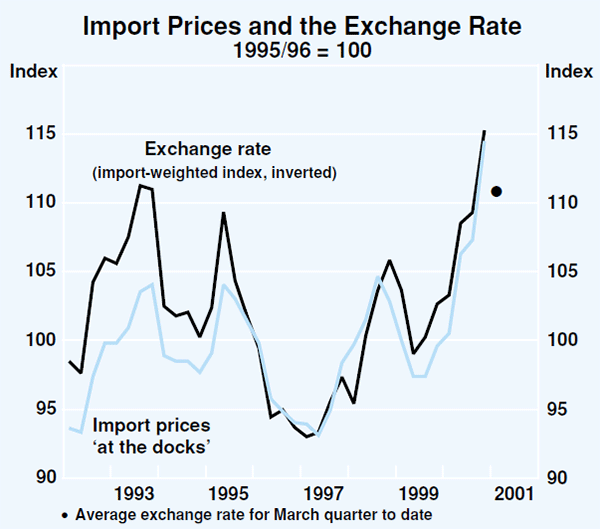
The lack of pass-through of the lower exchange rate to consumer prices is suggestive of a compression of margins in the retail sector, and is thus consistent with evidence of weaker profits in retailing (as discussed in the chapter on ‘Domestic Economic Activity’). This may reflect concerns about the strength of domestic demand or competitive pressures, and it could also reflect businesses' preferences only to pass through exchange rate changes that are expected to be long lasting. Although there remains the likelihood that the lower exchange rate will be reflected in consumer prices in coming quarters, the appreciation of the exchange rate in the early part of 2001 may have relieved this pressure a little, facilitating a rebuilding of retail margins without the need for as much adjustment of retail prices.
Producer prices
Producer prices have increased sharply over the past year, driven by rising world commodity prices, particularly for mineral fuels and basic metal products, and the depreciation of the exchange rate. In contrast to the outcomes for consumer prices, producer prices have increased more rapidly than generally expected. The most rapid increases have been evident at the earlier stages of production, with the impact of raw materials prices on final-stage prices diluted by other factors, such as capital costs, labour costs and profit margins, which tend to be less volatile than materials costs (Table 14).
| December quarter 2000 |
Year to December quarter 2000 |
|
|---|---|---|
| Preliminary | 2.9 | 10.3 |
| Domestic | 1.9 | 7.6 |
| Imported | 8.8 | 27.1 |
| Intermediate | 2.6 | 8.4 |
| Domestic | 1.7 | 6.4 |
| Imported | 8.5 | 21.8 |
| Final | ||
| Domestic(a) | 0.7 | 4.1 |
| – Consumption | 0.5 | 4.0 |
| – Capital | 0.8 | 4.0 |
| Imported | 5.6 | 10.6 |
| – Consumption | 5.1 | 11.3 |
| – Capital | 6.2 | 9.9 |
| Total(a) | 1.5 | 5.2 |
| – Consumption | 1.3 | 5.4 |
| – Capital | 1.8 | 5.1 |
| (a) Excluding exports | ||
Final producer prices (excluding exports) increased by 1.5 per cent in the December quarter to be 5.2 per cent higher than a year earlier. Substantial increases were recorded in import prices across all industries, largely as a result of the depreciation of the exchange rate. Domestic price rises were more moderate. The final-stage index for consumption goods has moved in line with the broader index, rising by 5.4 per cent over the year. While this index most closely parallels the composition of the CPI, it places a much higher weight on goods than does the CPI and is also measured at basic prices rather than retail prices, that is prior to the imposition of indirect taxes, transport costs and trade margins.
Sharp rises in the cost of raw materials have driven the rapid price rises at earlier stages of production. Rises in manufacturing input prices of around 26 per cent over the past 18 months have, in turn, resulted in higher growth in manufacturing output prices, which increased by 2.5 per cent in the December quarter and have increased by 12 per cent since mid 1999. The largest contributors to the overall increase have continued to be petroleum and coal products and basic metal products, although the December quarter increase was more broadly based. Excluding these two items, manufactured output prices increased by 1.3 per cent in the December quarter. The effect of the lower value of the currency on the cost of capital goods is evident, with the price of imported machinery rising strongly in the December quarter.
These rising inflation pressures have been partially offset by modest inflation in most non-tradeable sectors. The available data for the service sector suggest that inflation has generally remained subdued, although there have been sharp rises in prices for international transport and the cost of property services. Increases in construction costs have moderated. Abstracting from the effect of removing the WST from building materials prices, price increases for building materials used in housing construction have slowed sharply in conjunction with the downturn in the residential construction sector, while the price of non-residential construction materials continues to rise at a modest pace.
The sharp rise in producer prices, particularly for tradeable goods, suggests some upstream pressure on consumer prices in coming quarters, but there are indications that producer price inflation may have passed its peak. Abstracting from the imported components, the producer price data suggest that prices of domestically produced items have risen only modestly over the past two quarters, and the recent appreciation of the currency should also help to lessen the upstream price pressures.
The recent business surveys provide a broadly consistent picture; they report that growth in product prices has increased sharply over the past year but some moderation is likely in the period ahead. The economy-wide NAB survey has recorded a clear step-up in the rate at which firms expect to increase final product prices, and expectations are for similar increases in the March quarter to the increases recorded in the preceding two quarters (Graph 60). Retailers expect higher price rises, which the survey attributes to an intention to reverse the recent compression in margins. The ACCI-Westpac survey of manufacturers recorded a similarly marked step-up in the net balance of firms increasing their prices over the past year. Purchase costs, which have risen sharply in recent quarters, are expected to increase at a more moderate pace in the March quarter, according to both surveys.
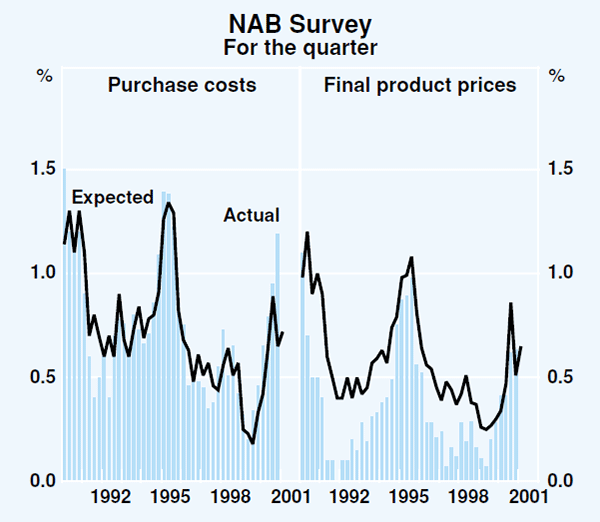
Labour costs
The broad range of wage indicators suggests that wages growth has begun to edge higher after a period of more moderate outcomes. The wage cost index (WCI) rose by 1.2 per cent in the September quarter and by 3.1 per cent over the year, up from the year-ended rate of 2.8 per cent in the previous quarter (Graph 61). While the quarterly rise in the WCI was the equal largest in the three years since the inception of the survey, it may be seasonal: outcomes in the September quarter have, to date, been larger than in other quarters (the data are not seasonally adjusted).
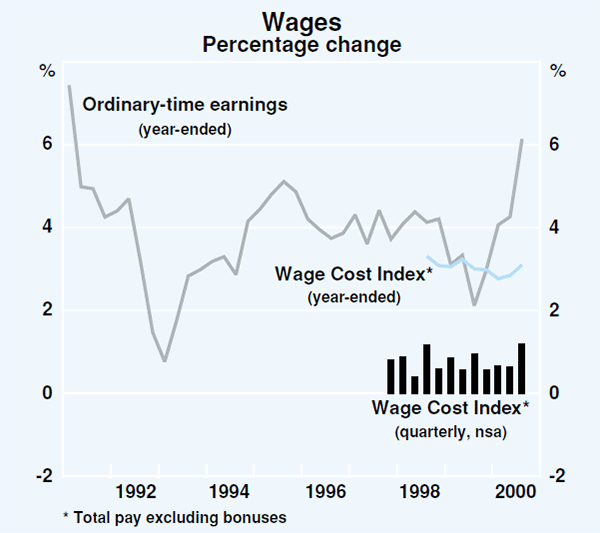
The size of wage increases provided by new federal enterprise agreements picked up in the September quarter to an average annualised rate of 4.1 per cent, from 3.4 per cent in the June quarter (Table 15). However, the extent of this pick-up was boosted by a couple of large public-sector agreements that were affected by significant renegotiation lags, resulting in the recorded wage increases being higher than would otherwise have been the case. The average annual wage increase in private-sector agreements, which may provide a better guide to emerging wages pressure, has risen from 3.5 per cent to 3.9 per cent over the past year. Further increases in this series may occur in the next couple of quarters, as annualised wage increases of between 4 and 4½ per cent contained in recent agreements reached in the Victorian manufacturing sector are included in the series.
| Mar 2000 |
June 2000 |
Sep 2000 |
|
|---|---|---|---|
| Wage cost index(a) | |||
| Private | 2.9 | 2.9 | 3.1 |
| Public | 2.5 | 2.7 | 2.9 |
| Total | 2.8 | 2.8 | 3.1 |
| Average weekly earnings survey | |||
| AWOTE | 4.1 | 4.3 | 6.1 |
| AWE | 2.8 | 3.9 | 6.8 |
| Executive remuneration | |||
| Base salaries | 4.6 | 4.5 | 4.6 |
| New federal enterprise agreements(b) | |||
| Private | 3.6 | 3.8 | 3.9 |
| Public | 3.2 | 3.0 | 4.3 |
| Total | 3.4 | 3.4 | 4.1 |
|
(a) Total pay excluding bonuses Source: ABS, DEWRSB, Mercer Cullen Egan Dell |
|||
In contrast to the moderate increases shown in other wage measures, average weekly ordinary-time earnings (AWOTE) have risen very rapidly in recent quarters, to be 6.1 per cent higher over the year to August 2000 compared with a year-ended growth rate of 2.1 per cent recorded a year earlier. Notwithstanding the tightening of labour market conditions during 2000, the extent of the pick-up in wages growth recorded by AWOTE seems to be overstated. It may partly represent a correction for the surprising weakness that was evident in this measure of wages in the latter half of 1999. AWOTE is a measure of the wage bill per employee and is therefore affected by changes in the underlying composition of employment. Measures of labour costs reported in the national accounts, which are also derived from a wage bill, have shown a much smaller acceleration from a little below 2½ per cent in late 1999 to just below 3½ per cent over the year to the September quarter 2000. If non-wage costs are excluded, the pick-up in growth is only slight.
The Mercer Cullen Egan Dell (MCED) salary review for the December quarter reported that the base salary of executives grew by 4.8 per cent over the course of 2000, up slightly from the average rate of 4.6 per cent recorded in the preceding four quarters. The base salary component does not include any bonuses or returns from participation in corporate share schemes. Data from the MCED survey suggest that the growth of non-executive pay has remained steady at a little over 4 per cent (Graph 62).
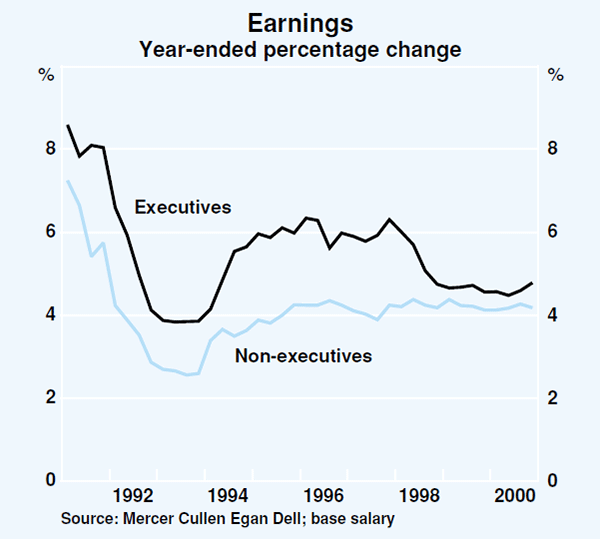
The latest business surveys suggest that there is little further upward pressure on wages growth. The December quarter ACCI-Westpac survey of manufacturers reported a sharp decline in the net balance of firms finding it more difficult to find labour. The broader NAB survey reported that the percentage of firms which cite the availability of suitable labour as a constraint on current output growth has eased from the high levels recorded in late 1999.
One uncertainty in the wages outlook has been the potential for additional wage increases triggered by GST-related clauses contained in some enterprise agreements. In recent quarters the proportion of private-sector employees covered by GST-related clauses has risen, although it remains relatively low. This increase has been largely driven by a rise in the number of clauses that seek to reopen wage negotiations should inflation exceed expectations or some defined benchmark, rather than clauses providing full or partial indexing of wages to the CPI. The lower-than-expected CPI outcomes since the introduction of the tax changes have, however, reduced the likelihood of significant extra wage claims being generated by this mechanism.
The Safety Net Review of award wages is currently being undertaken by the Australian Industrial Relations Commission (AIRC). The AIRC will consider an application by the Australian Council of Trade Unions (ACTU) to increase award rates of pay from the federal minimum wage ($400.40 per week) up to $492.20 by $28 per week, and by 5.7 per cent for award rates above this. A decision is expected in late April.
Inflation expectations
Most broad measures of inflation expectations have fallen in recent months, suggesting that factors such as the introduction of the GST, higher oil prices and the lower exchange rate are more likely to have a temporary effect on the inflation rate than add to ongoing inflation pressures.
Consumers' expectations of inflation, as surveyed by the Melbourne Institute, have declined since the introduction of the tax changes in mid 2000, to around the level prevailing in 1998 (Graph 63). The median expectation of inflation over the next year has fallen from a peak of over 8 per cent in May 2000 to 3.9 per cent in January 2001, its lowest level in two years. The latest decline is likely to have been influenced by the lower petrol prices prevailing when the survey was taken in mid January.
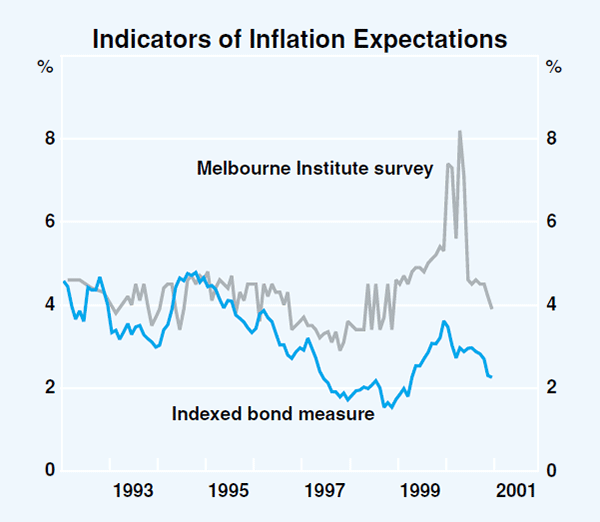
Financial market economists revised down their inflation forecasts following the unexpectedly low December quarter 2000 CPI outcome. The median inflation forecast of market economists surveyed by the Bank decreased by around ½ of one percentage point for both the current financial year and the next. For the year to June 2001, inflation is forecast to be 5 per cent in headline terms and 2.3 per cent excluding tax effects, and for the year to June 2002, inflation is forecast to be 2 per cent (Table 16). The median estimate of the first-year tax effect is 2¾ per cent, and the majority of respondents expect taxes to have little effect on inflation over the following year. Most respondents expect further appreciation of the exchange rate and falls in oil prices over the next 18 months.
| Year to June 2001 | Year to June 2002 | ||||||
|---|---|---|---|---|---|---|---|
| Aug 2000 |
Nov 2000 |
Feb 2001 |
Aug 2000 |
Nov 2000 |
Feb 2001 |
||
| Market economists(a) | |||||||
| CPI | 5.5 | 5.4 | 5.0 | 2.3 | 2.4 | 2.0 | |
| – Excluding GST | 2.8 | 2.8 | 2.3 | 2.4 | 2.4 | 2.1 | |
| Union officials(b) | |||||||
| ‘Inflation’ | 5.3 | 6.0 | 4.5 | 4.2 | 4.5 | 3.5 | |
| (a) RBA survey (b) ACIRRT survey |
|||||||
The inflation forecasts of trade union officials, as surveyed by the Australian Centre for Industrial Relations Research and Training (ACIRRT), have been lowered even more sharply. Inflation is now expected to be at least 1 percentage point lower, in both this year and the next, than was forecast three months ago.
Longer-term inflation expectations of financial market participants, measured by the difference between nominal and indexed 10-year bond yields, have also fallen. The ¾ of a percentage point fall in nominal bond yields since October, which outstripped the fall in indexed bond yields, is similar to the sharp scaling-back of inflation expectations in global bond markets over the period. These bond yields imply that long-term inflation expectations are currently around 2¼ per cent, down from around 3¾ per cent a year ago, but a little above the low levels recorded in 1998.
Medium-term inflation expectations of businesses, in contrast to the other measures, have been broadly unchanged over the past six months and remain well above the level prevailing a couple of years ago. The December quarter NAB survey indicated that around 60 per cent of firms expect inflation to average 3–4 per cent over the next five years, up from 50 per cent in early 1999, and a little over 25 per cent of firms expect inflation to be less than 3 per cent, down from over 40 per cent in early 1999. The difference between this and other measures of inflation expectations may reflect the higher weight that businesses place on developments in producer prices and purchase costs when forming their expectations.
Inflation outlook
It has been difficult to gauge the strength of underlying price pressures in recent quarters. Measures of inflation have been significantly affected by the recent indirect tax changes, most of which occurred in the September quarter 2000. The size and timing of these effects on prices have been difficult to determine with confidence. The introduction of the new tax system also contributed to heightened levels of activity in some sectors earlier in the year, which had some temporary inflationary consequences. Excluding the estimated effects of the tax changes and other temporary factors, such as higher oil prices, the Bank's assessment is that inflation has probably been running at around 2 per cent over the past year.
Inflation has for some time been expected to increase in underlying terms, reflecting the buoyant conditions in the domestic economy that prevailed up to the middle of 2000 as well as some sharp increases in raw materials costs and import prices over the past year. Recent developments suggest that demand factors are unlikely to place as much upward pressure on inflation as had been expected a few months ago. After growing at an average rate of around 4¾ per cent over the past three years, the economy now seems likely to experience a period of lower growth, partly reflecting the softer outlook for the world economy.
Rising labour costs also appear to pose less of a risk to the inflation outlook than previously seemed likely. Our assessment is that wages growth has picked up a little in recent periods. With conditions in the labour market having eased in recent months, and consumers' inflation expectations declining to their lowest level in two years, however, the likely extent of further acceleration in wages is limited. The lower-than-expected outcomes for inflation in the second half of 2000 also make it less likely that CPI or GST-related clauses in wage agreements will be triggered.
The recent strong growth in producer and wholesale prices, however, is still expected to generate some upward pressure on inflation in the near term. The sharply lower exchange rate, coupled with higher global commodity prices over the past year, have contributed to rapid increases in both materials costs and the prices of imported goods recorded at the docks. Other than for petrol, however, these price increases are yet to have a discernible impact on retail prices. The prices of items with a large import component have been relatively subdued at the retail level, as have been the prices of tradeable items more generally. Past experience has been that such upstream price pressures typically take some time to flow through to retail prices, and if they are spread over a long enough period of time they may have little perceptible effect on inflation outcomes. The risk remains, however, that the pass-through of these cost increases could boost inflation noticeably in the next few quarters, although the appreciation of the exchange rate in the early part of 2001 could act to alleviate some of this pressure.
Despite the near-term price pressures likely to be associated with import prices and materials costs, the longer-term outlook for inflation appears to be more secure than it did a few months ago. Inflation expectations on the part of financial market participants and consumers have eased further in recent months, as the near-term outlook for activity has softened and the new tax system has been bedded down. Compared with three months ago, the risk that the price spike associated with the introduction of the GST would lead to a step-up in ongoing inflation has thus receded considerably. These lower inflation expectations suggest that should a temporary increase in inflation occur, it is less likely to result in a persistent inflation problem than would have been the case a quarter or two ago. In addition, it should be noted that petrol prices are unlikely to contribute to headline inflation in the period ahead in the way that they have done over the past year. Petrol prices have declined in recent months and are likely to subtract from the CPI in the March quarter.
Overall, the Bank's assessment is that inflation, abstracting from the temporary effects of the tax changes and movements in oil prices, is likely to increase only slightly in the near term and will remain well within the 2–3 per cent target during the next couple of years. On a year-ended basis, headline CPI inflation will continue to be held up by the net effects of the new tax system until the middle of 2001. It is then expected to fall a little below underlying measures of inflation, reflecting an assumed further easing in world oil prices and the scheduled removal of some additional indirect taxes.
This outlook is based on the standard technical assumption that the exchange rate remains around recent levels, an assumption that is clearly subject to uncertainties in both directions. Also uncertain is the speed at which the upstream cost and price increases that have already occurred will feed through to retail prices. It is possible that a more significant pass-through of these increases will occur than is currently assumed. An important additional source of uncertainty concerns the outlook for growth in the global economy. Recent assessments of likely growth in the world economy have shifted noticeably lower, and there remain further downside risks in that area, although recent monetary policy actions will obviously be working to offset those risks. If there were a significant further weakening in the global economy, it would probably entail somewhat lower inflation prospects both in Australia and abroad.
Footnote
Covers Hong Kong, Indonesia, Korea, Malaysia, the Philippines, Singapore, Taiwan and Thailand. [1]
Footnote Box A
This box focuses on June balancing companies, which account for the bulk of company tax collections. Similar arrangements apply to companies which balance at other times of the year. The analysis abstracts from changes in the company tax rate, which was lowered from 36 per cent to 34 per cent on income earned in 2000/01. [1]
Footnote Box B
An inflation rate of 2¼ per cent was used for the September quarter 2000 and 2 per cent for the December quarter and the latest estimate. [1]